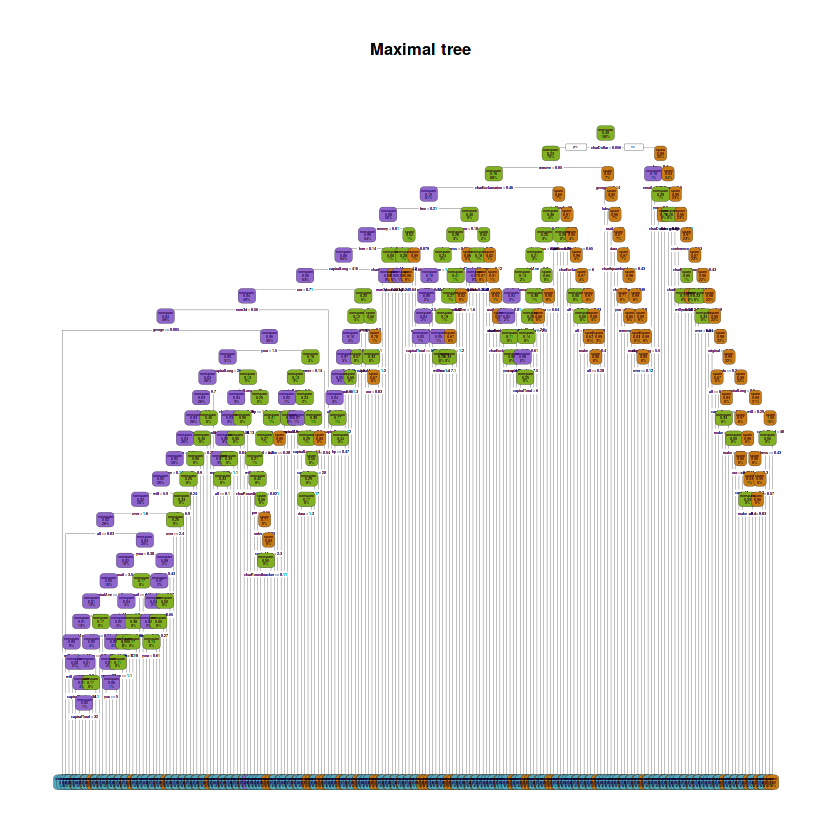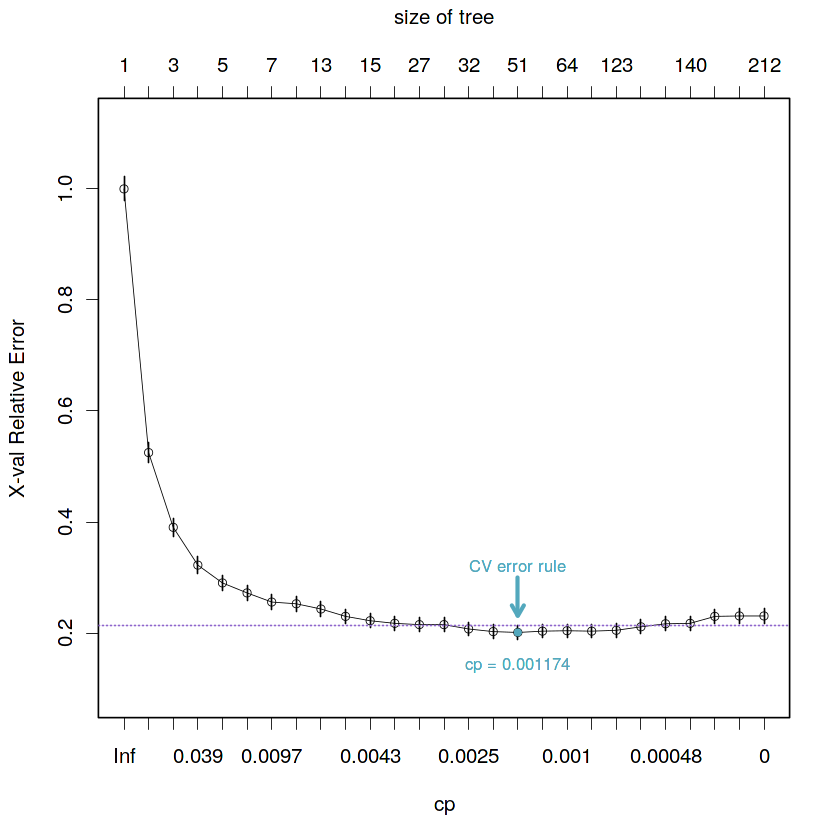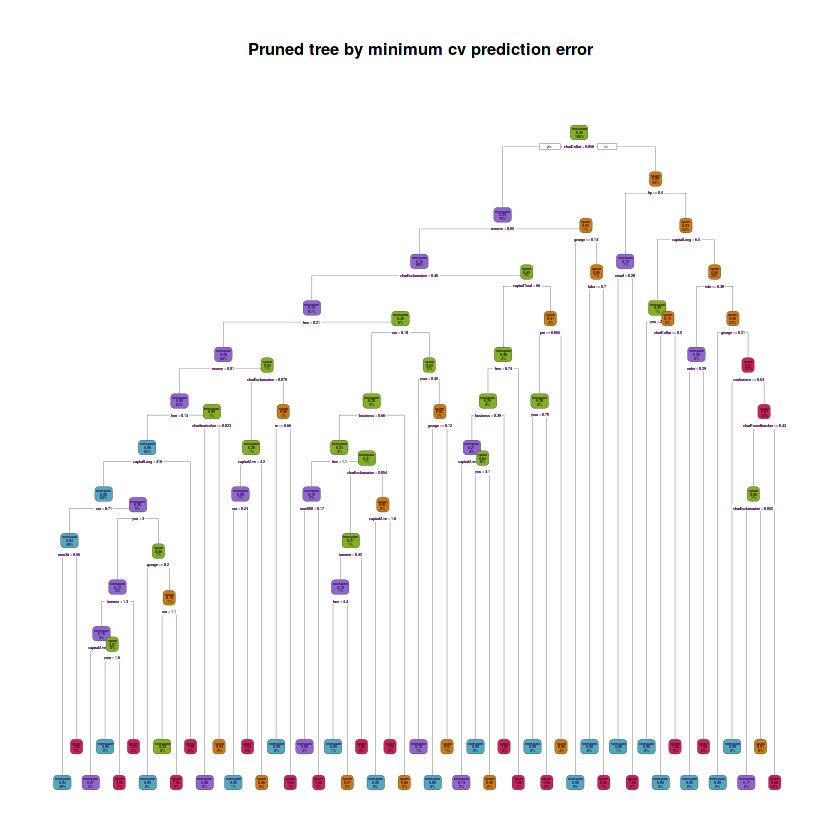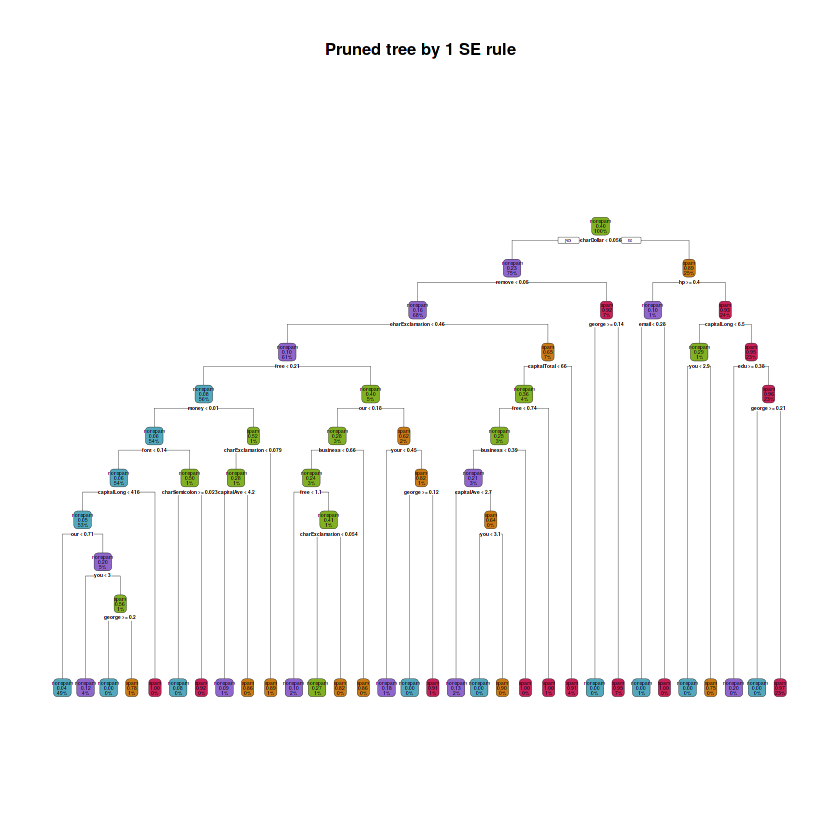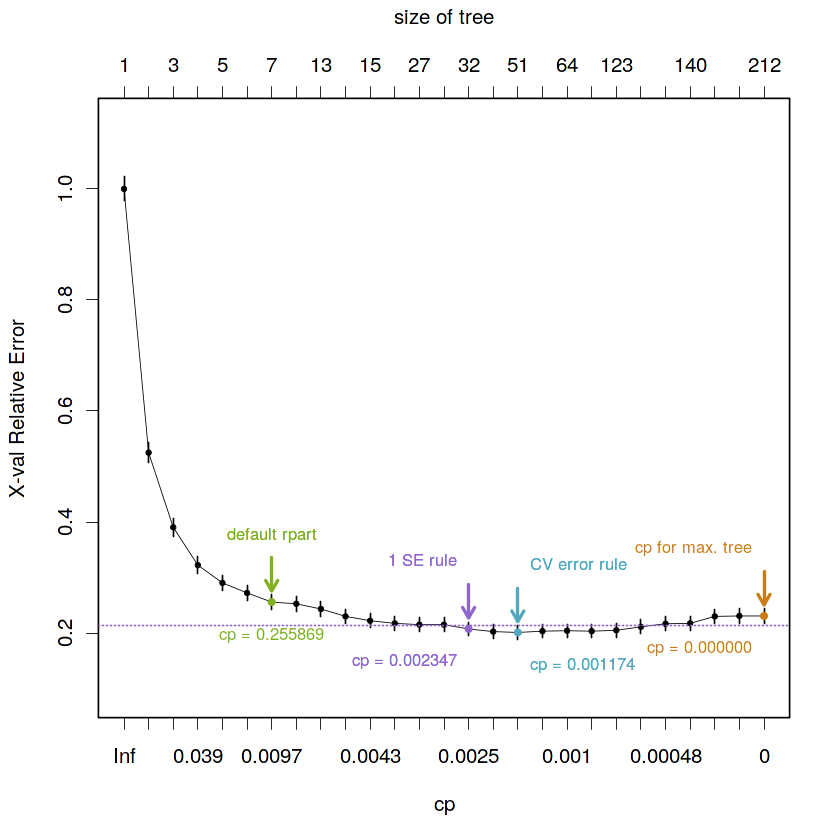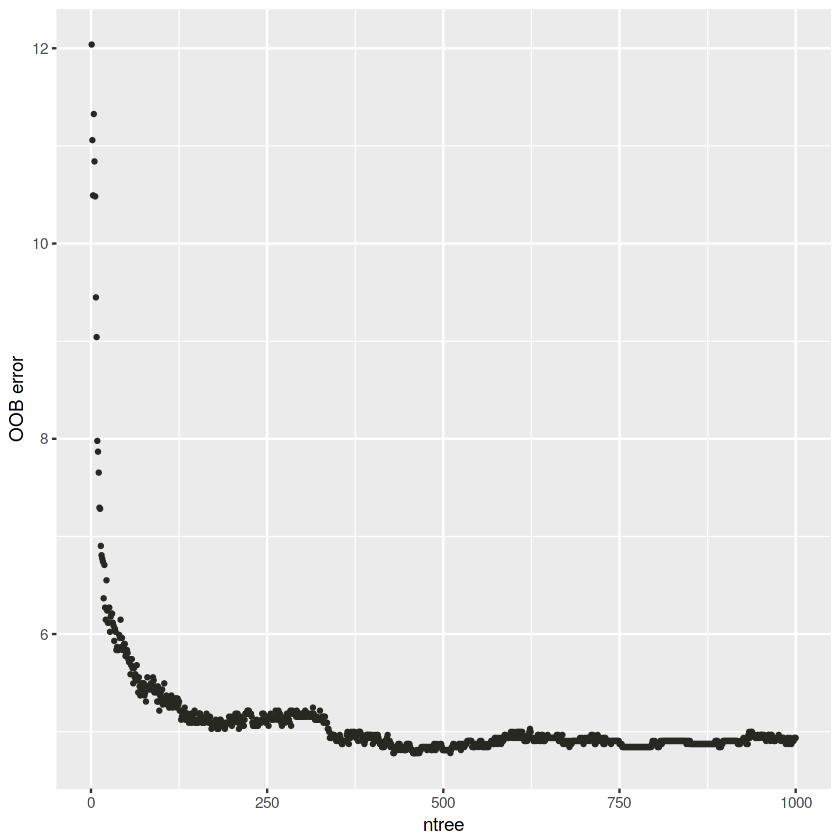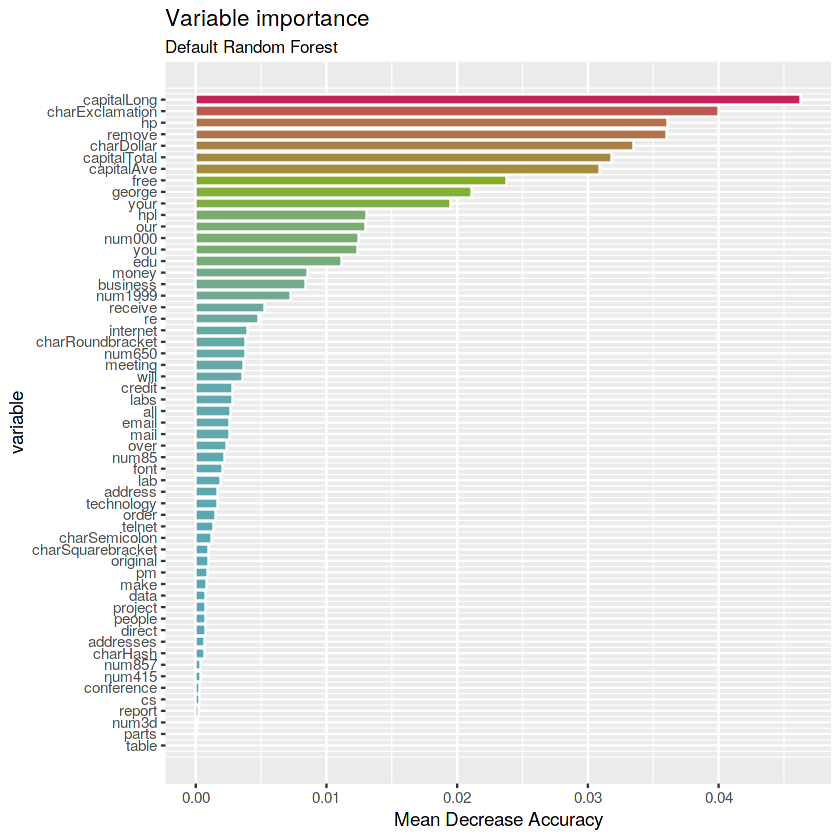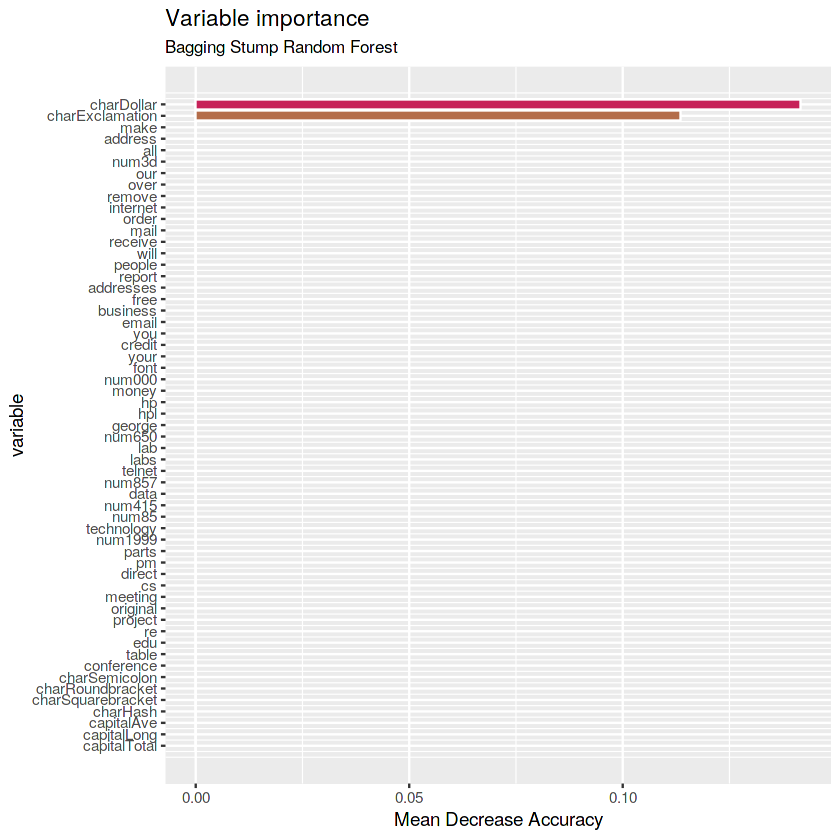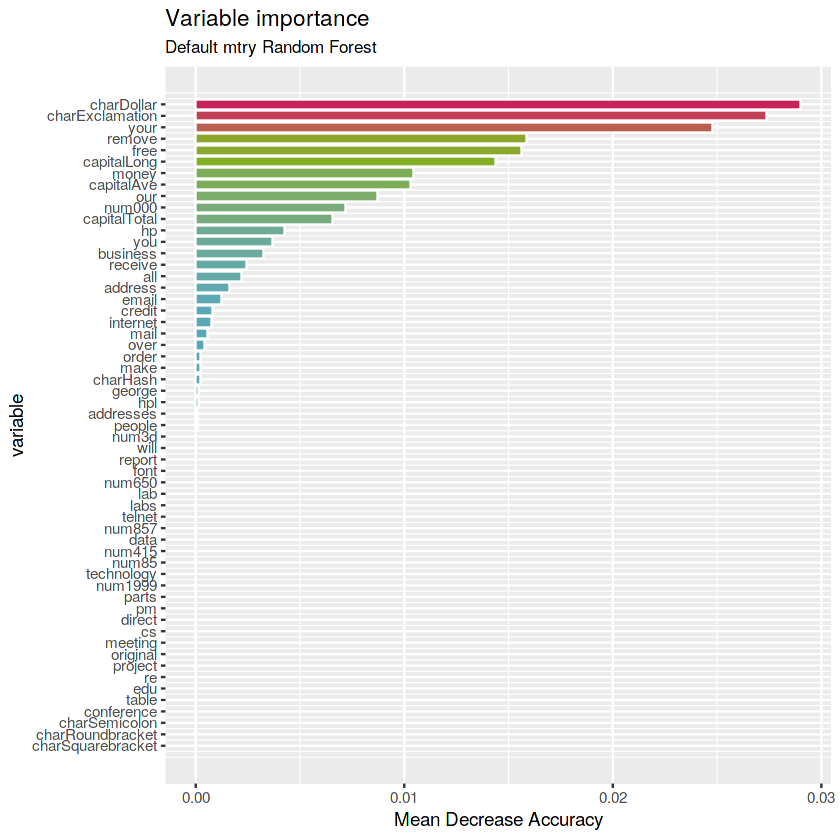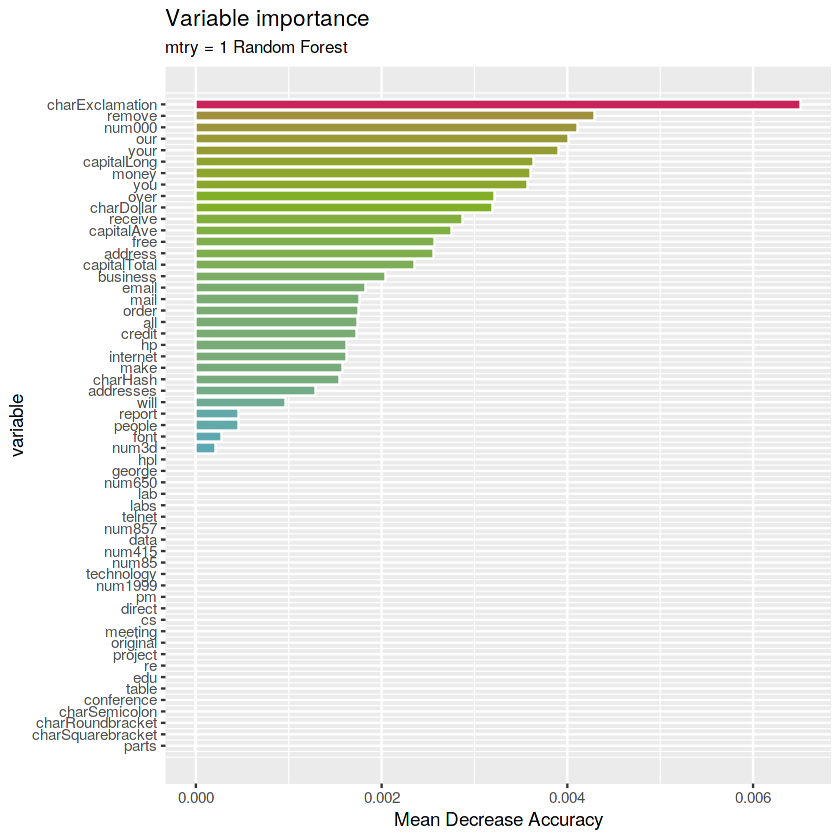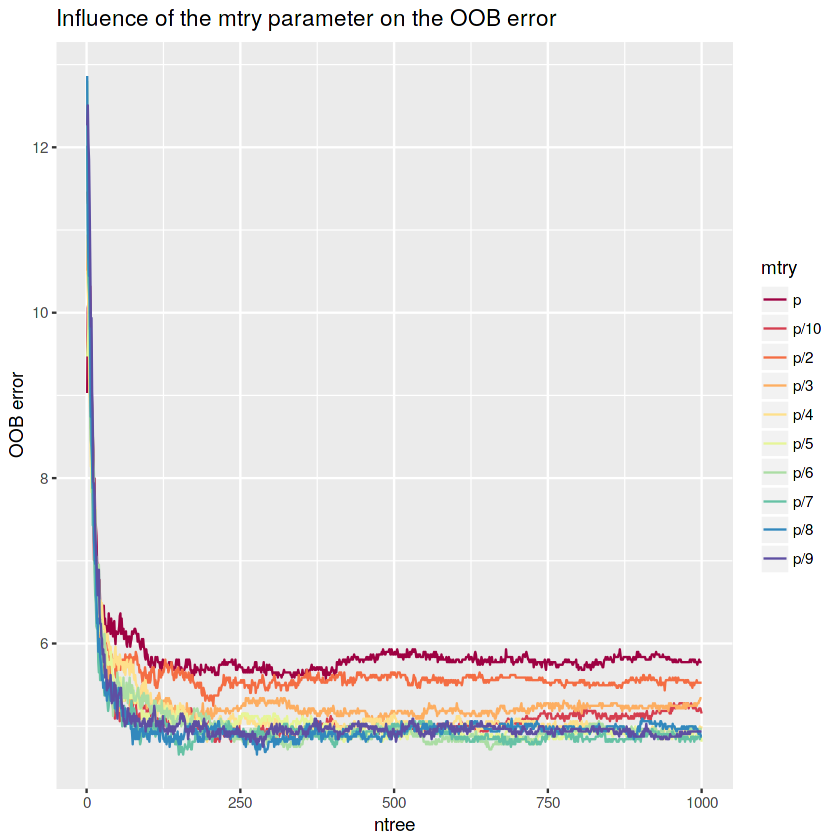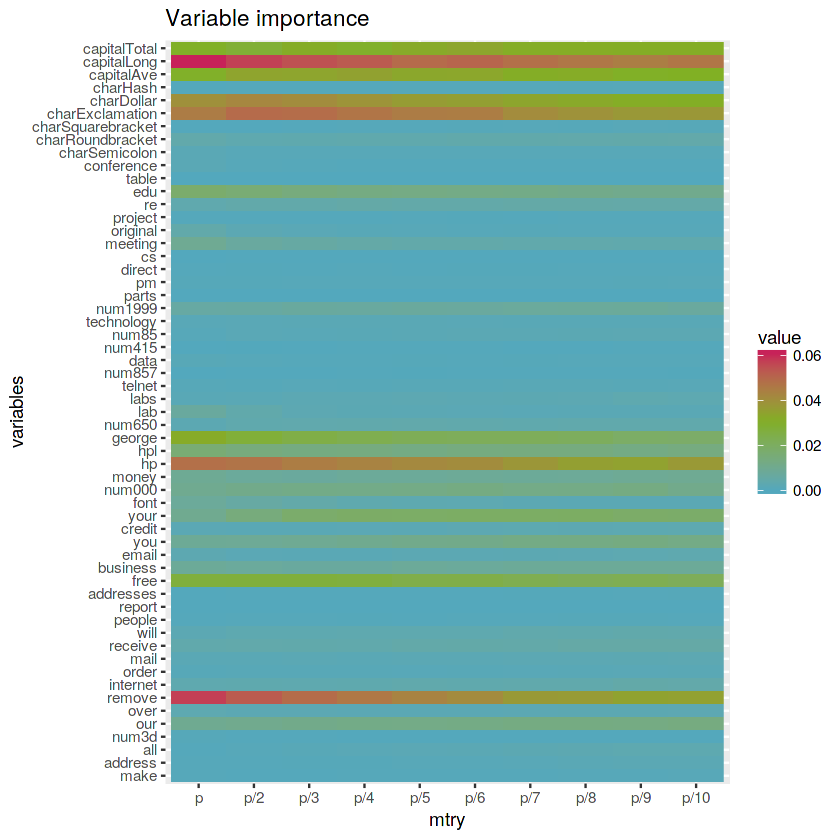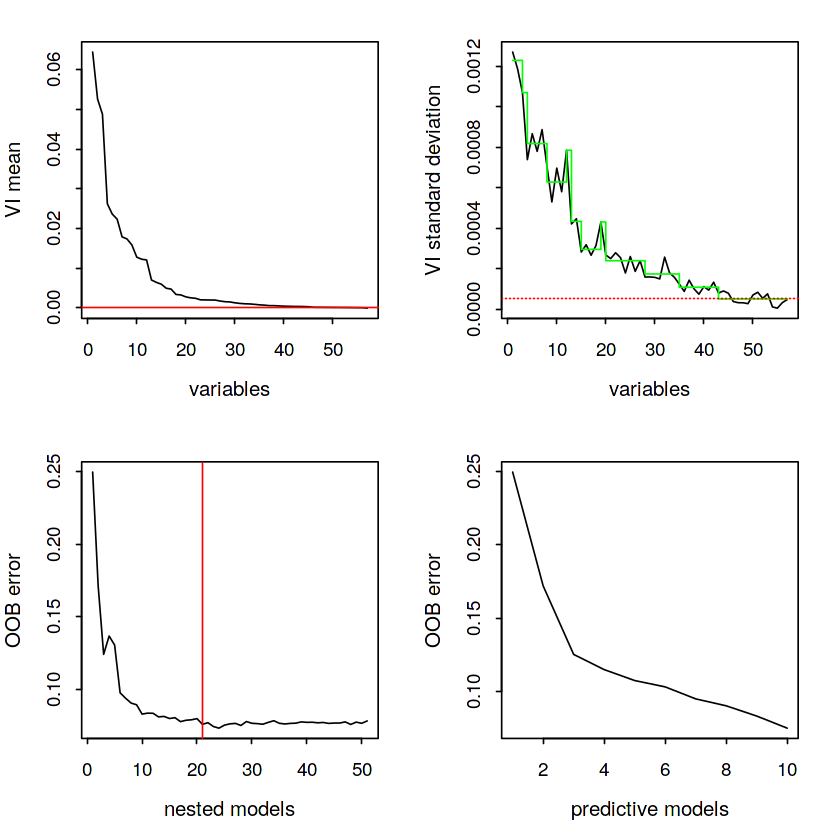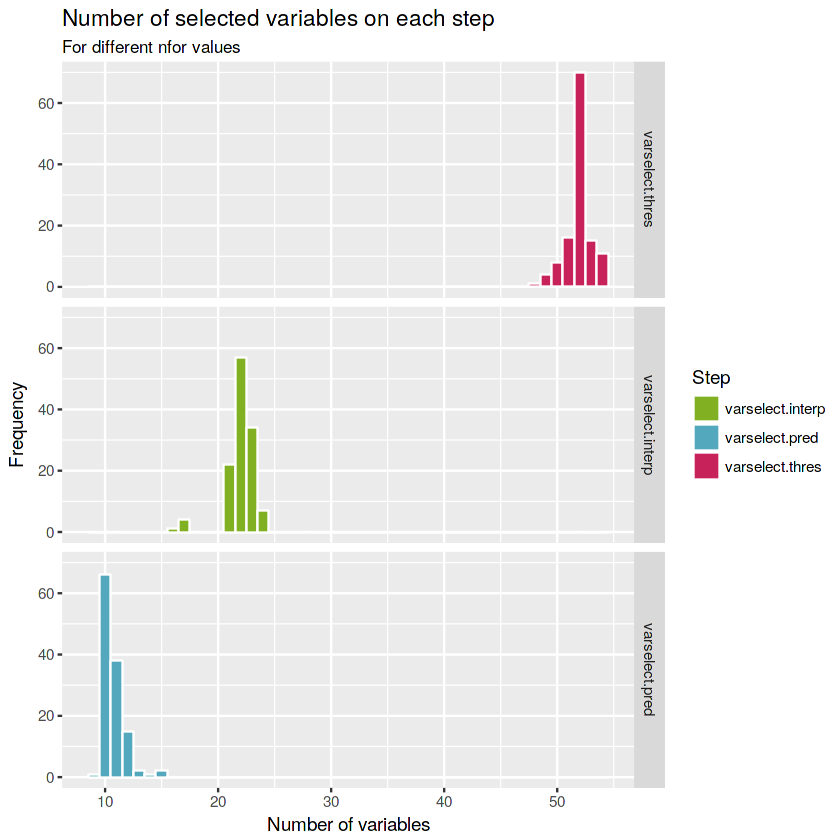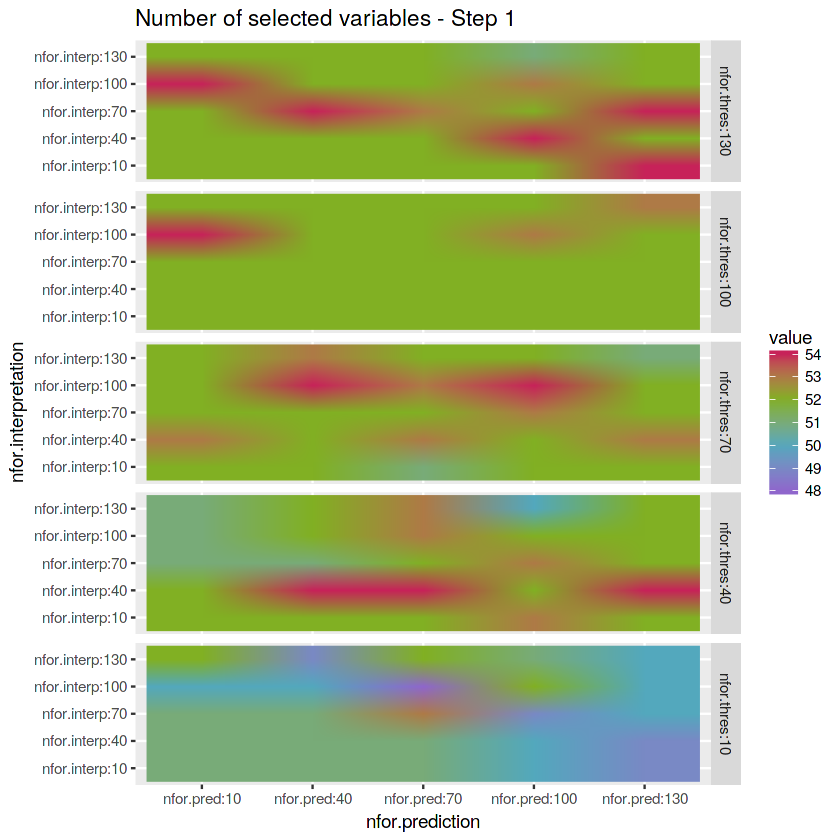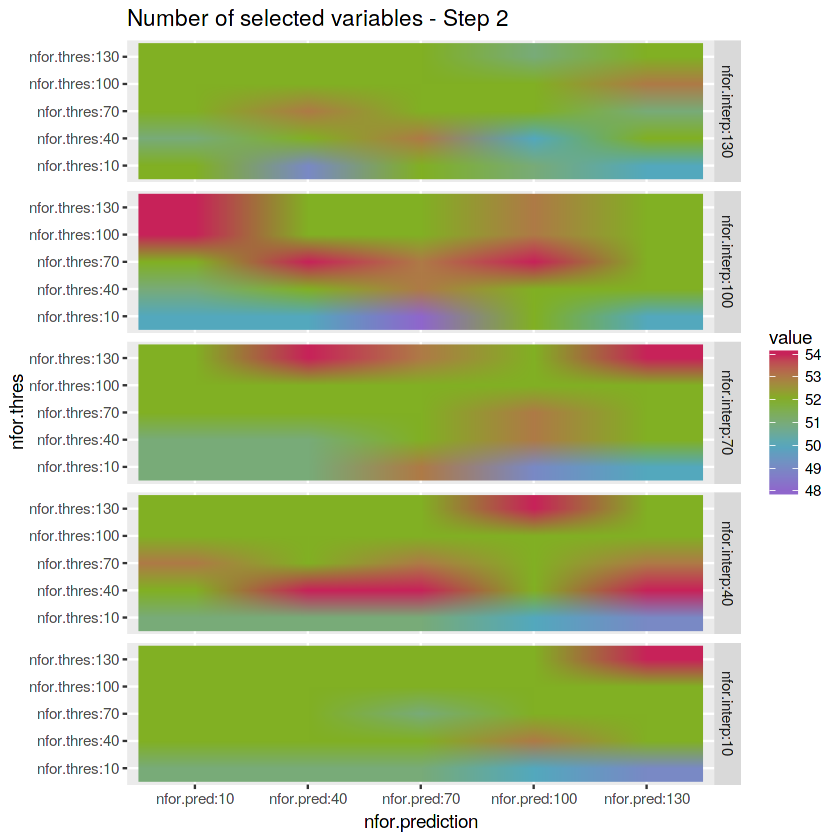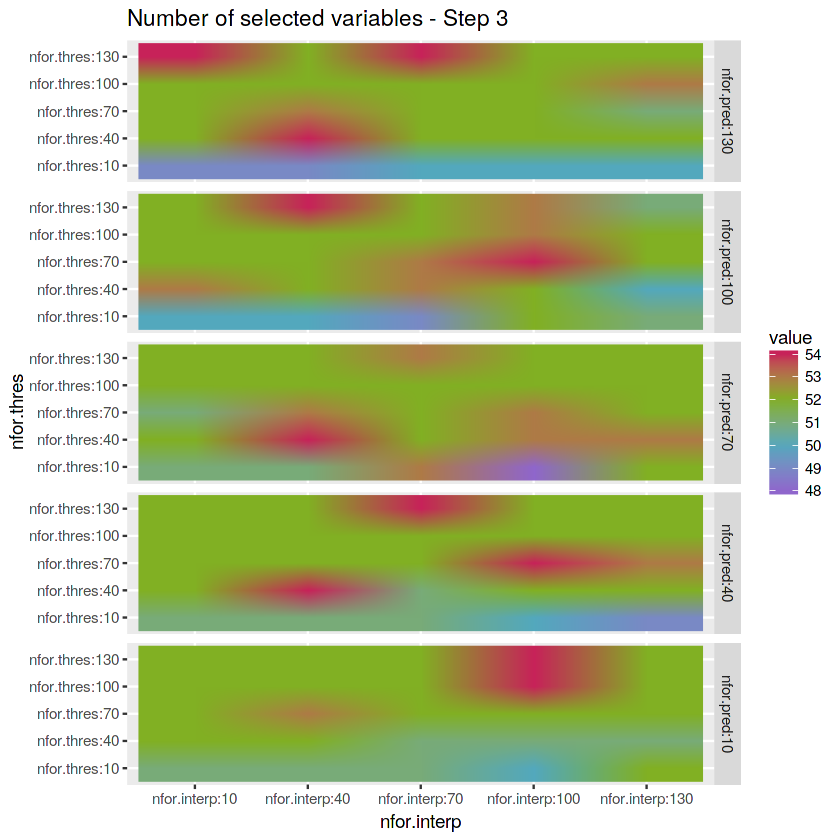Guide for the practice sessions with the companion scenario, the documentation cran.r-project.org/web/packages/VSURF/index.html and the two articles: journal.r-project.org/archive/2015-2/genuer-poggi-tuleaumalot.pdf hal-descartes.archives-ouvertes.fr/hal-01387654v2
- Student: Guzmán López Orrego
- Contact: [email protected]
- Source code available at: github/guzmanlopez
- Online document available at: Jupyter Notebook
The kernlab library in
Rwill be used only to load the spam dataset.
# Load library
library(kernlab)1.2. Load the dataset spam in R and build the dataframes of learning and test sets (the first will be used for designing trees, the second for evaluating errors)
- Explore the spam dataset
# Load data
data(spam)# Explore the spam dataset
# ?spam# See the spam dataset structure
str(spam)'data.frame': 4601 obs. of 58 variables:
$ make : num 0 0.21 0.06 0 0 0 0 0 0.15 0.06 ...
$ address : num 0.64 0.28 0 0 0 0 0 0 0 0.12 ...
$ all : num 0.64 0.5 0.71 0 0 0 0 0 0.46 0.77 ...
$ num3d : num 0 0 0 0 0 0 0 0 0 0 ...
$ our : num 0.32 0.14 1.23 0.63 0.63 1.85 1.92 1.88 0.61 0.19 ...
$ over : num 0 0.28 0.19 0 0 0 0 0 0 0.32 ...
$ remove : num 0 0.21 0.19 0.31 0.31 0 0 0 0.3 0.38 ...
$ internet : num 0 0.07 0.12 0.63 0.63 1.85 0 1.88 0 0 ...
$ order : num 0 0 0.64 0.31 0.31 0 0 0 0.92 0.06 ...
$ mail : num 0 0.94 0.25 0.63 0.63 0 0.64 0 0.76 0 ...
$ receive : num 0 0.21 0.38 0.31 0.31 0 0.96 0 0.76 0 ...
$ will : num 0.64 0.79 0.45 0.31 0.31 0 1.28 0 0.92 0.64 ...
$ people : num 0 0.65 0.12 0.31 0.31 0 0 0 0 0.25 ...
$ report : num 0 0.21 0 0 0 0 0 0 0 0 ...
$ addresses : num 0 0.14 1.75 0 0 0 0 0 0 0.12 ...
$ free : num 0.32 0.14 0.06 0.31 0.31 0 0.96 0 0 0 ...
$ business : num 0 0.07 0.06 0 0 0 0 0 0 0 ...
$ email : num 1.29 0.28 1.03 0 0 0 0.32 0 0.15 0.12 ...
$ you : num 1.93 3.47 1.36 3.18 3.18 0 3.85 0 1.23 1.67 ...
$ credit : num 0 0 0.32 0 0 0 0 0 3.53 0.06 ...
$ your : num 0.96 1.59 0.51 0.31 0.31 0 0.64 0 2 0.71 ...
$ font : num 0 0 0 0 0 0 0 0 0 0 ...
$ num000 : num 0 0.43 1.16 0 0 0 0 0 0 0.19 ...
$ money : num 0 0.43 0.06 0 0 0 0 0 0.15 0 ...
$ hp : num 0 0 0 0 0 0 0 0 0 0 ...
$ hpl : num 0 0 0 0 0 0 0 0 0 0 ...
$ george : num 0 0 0 0 0 0 0 0 0 0 ...
$ num650 : num 0 0 0 0 0 0 0 0 0 0 ...
$ lab : num 0 0 0 0 0 0 0 0 0 0 ...
$ labs : num 0 0 0 0 0 0 0 0 0 0 ...
$ telnet : num 0 0 0 0 0 0 0 0 0 0 ...
$ num857 : num 0 0 0 0 0 0 0 0 0 0 ...
$ data : num 0 0 0 0 0 0 0 0 0.15 0 ...
$ num415 : num 0 0 0 0 0 0 0 0 0 0 ...
$ num85 : num 0 0 0 0 0 0 0 0 0 0 ...
$ technology : num 0 0 0 0 0 0 0 0 0 0 ...
$ num1999 : num 0 0.07 0 0 0 0 0 0 0 0 ...
$ parts : num 0 0 0 0 0 0 0 0 0 0 ...
$ pm : num 0 0 0 0 0 0 0 0 0 0 ...
$ direct : num 0 0 0.06 0 0 0 0 0 0 0 ...
$ cs : num 0 0 0 0 0 0 0 0 0 0 ...
$ meeting : num 0 0 0 0 0 0 0 0 0 0 ...
$ original : num 0 0 0.12 0 0 0 0 0 0.3 0 ...
$ project : num 0 0 0 0 0 0 0 0 0 0.06 ...
$ re : num 0 0 0.06 0 0 0 0 0 0 0 ...
$ edu : num 0 0 0.06 0 0 0 0 0 0 0 ...
$ table : num 0 0 0 0 0 0 0 0 0 0 ...
$ conference : num 0 0 0 0 0 0 0 0 0 0 ...
$ charSemicolon : num 0 0 0.01 0 0 0 0 0 0 0.04 ...
$ charRoundbracket : num 0 0.132 0.143 0.137 0.135 0.223 0.054 0.206 0.271 0.03 ...
$ charSquarebracket: num 0 0 0 0 0 0 0 0 0 0 ...
$ charExclamation : num 0.778 0.372 0.276 0.137 0.135 0 0.164 0 0.181 0.244 ...
$ charDollar : num 0 0.18 0.184 0 0 0 0.054 0 0.203 0.081 ...
$ charHash : num 0 0.048 0.01 0 0 0 0 0 0.022 0 ...
$ capitalAve : num 3.76 5.11 9.82 3.54 3.54 ...
$ capitalLong : num 61 101 485 40 40 15 4 11 445 43 ...
$ capitalTotal : num 278 1028 2259 191 191 ...
$ type : Factor w/ 2 levels "nonspam","spam": 2 2 2 2 2 2 2 2 2 2 ...
To continue exploring the spam dataset, the tidyverse and the ggridges libraries will be loaded into the
Renvironment. They will be used to manipulate and visualize data.
# Load libraries
library(tidyverse)
library(ggridges)── Attaching packages ─────────────────────────────────────── tidyverse 1.2.1 ──
✔ ggplot2 2.2.1.9000 ✔ purrr 0.2.4
✔ tibble 1.4.2 ✔ dplyr 0.7.4
✔ tidyr 0.8.0 ✔ stringr 1.3.0
✔ readr 1.1.1 ✔ forcats 0.3.0
── Conflicts ────────────────────────────────────────── tidyverse_conflicts() ──
✖ ggplot2::alpha() masks kernlab::alpha()
✖ purrr::cross() masks kernlab::cross()
✖ dplyr::filter() masks stats::filter()
✖ dplyr::lag() masks stats::lag()
Establish manual colors from Monokai palette to use in plots and as a general color theme.
# Create manual colors
lightgray <- "#75715E"
gray <- "#4D4D4D"
darkgray <- "#272822"
red <- "#C72259"
orange <- "#C97C16"
green <- "#81B023"
purple <- "#8F66CC"
blue <- "#53A8BD"- Create boxplots of variables
Create the function called
boxplotOfSpamVarsto build boxplots of any variable/s selected from the spam dataset
# Create function
boxplotOfSpamVars <- function(vars) {
# Reshape the spam data to make a boxplot
spam.gather <- spam %>%
select(c("type", vars)) %>%
gather(key = "var", value = "values", -type)
# Create a boxplot of every variable separeted by the variable type (spam and nonspam)
spam.boxplot <- ggplot() +
geom_boxplot(data = spam.gather, aes(x = var, y = values, color = type),
lwd = 0.25, alpha = 0.5) +
scale_color_manual(values = c(green, red), name = "type")
# Create faceting
spam.boxplot + facet_grid(var ~ ., scales = "free")
}
# Explore charExclamation and remove variables
boxplotOfSpamVars(vars = c("charExclamation", "remove", "capitalTotal"))It seems that the character exclamation symbol (charExclamation), the total number of capital letters (capitalTotal) and the presence of the word remove are more frequent in spam mails than in nonspam mails.
- Create density plots of standarized variables to compare their distributions. 1) Center variables by subtracting their means (omitting NAs). 2) Divide the centered variables by their standard deviations
# Standardization of all the predictor variables
spam.norm <- as.data.frame(scale(spam[, -58]))
spam.norm$type <- spam$type# Manipulate the standarized spam.norm data to allow making a density plot of all the variables
spam.norm.gather <- spam.norm %>%
gather(key = "var", value = "values", -type) %>% # reshape
group_by(var, type) # group by columns 'var' and 'type'
# Pint the first 6 rows of the new manipulated data.frame
head(spam.norm.gather)| type | var | values |
|---|---|---|
| spam | make | -0.3423965 |
| spam | make | 0.3453219 |
| spam | make | -0.1459055 |
| spam | make | -0.3423965 |
| spam | make | -0.3423965 |
| spam | make | -0.3423965 |
# Create a ggplot of standarized variables densities
ggplot(spam.norm.gather) +
geom_density_ridges(aes(x = values,
y = factor(as.character(spam.norm.gather$var),
levels = rev(unique(as.character(spam.norm.gather$var)))),
fill = type), alpha = 0.6, lwd = 0.05, scale = 3) +
scale_y_discrete(name = "predictor variable", expand = c(0.06, 0)) +
scale_x_continuous(name = "standarized values", expand = c(0, 0), limits = c(-1, 1)) +
scale_fill_manual(values = c(green, red), name = "type")Picking joint bandwidth of 0.0332
Warning message:
“Removed 15243 rows containing non-finite values (stat_density_ridges).”
Looking at the above figure, it seems that the variables capitalAve, capitalLong and capitalTotal have markedly different peaks for spam and nonspam distributions.
- Build dataframes by sampling
# Set seed
set.seed(20)
# Add id column to spam data.frame
spam$ID <- 1:nrow(spam)
# Train data.frame
train <- spam %>% sample_frac(size = 0.70, replace = FALSE) # 70% of data for train
# Test data.frame
test <- spam[-train$ID, ] # 30% of the data for test
# Remove ID column
spam <- spam[, -59]
train <- train[, -59]
test <- test[, -59]The learn dataset is the object named
traindataset
library(rpart)The rpart is an
Rlibrary for "Recursive partitioning for classification, regression and survival trees. It is an implementation of most of the functionality of the 1984 book by Breiman, Friedman, Olshen and Stone. It also includes similar Fortran code in the source."
# Default rpart tree with train data
fit.train.def <- rpart(type ~ ., data = train, method = 'class')Plot the default tree using the library rpart.plot for better tree visualization.
# Load library
library("rpart.plot")# Plot tree
rpart.plot(fit.train.def, main = "Default rpart tree",
box.palette = rev(c(red, orange, green, purple, blue)), type = 2)Each node of the binary model tree shows:
- the predicted class (spam or nonspam)
- the predicted probability of spam
- the percentage of observations in the node
# Depth of tree
cat("The depth of the default tree is:",
max(rpart:::tree.depth(as.numeric(rownames(fit.train.def$frame)))), "\n")
# Number of leaves
cat("The number of leaves is:",
sum(fit.train.def$frame$var == "<leaf>"), "\n")
# Variables involved in splits
cat("The splits involved the following variables: \n")
purrr::map(unique(fit.train.def$frame$var[which(fit.train.def$frame$var != "<leaf>")]),
~ paste(as.character(.x)))The depth of the default tree is: 5
The number of leaves is: 7
The splits involved the following variables:
- 'charDollar'
- 'remove'
- 'charExclamation'
- 'capitalTotal'
- 'free'
- 'hp'
The default
rparttree has a depth of 5, it has 7 leaves and the splits involved 6 variables: charDollar, remove, hp, charExclamation, capitalTotal and free. A high frequency of dollar sign characters, hp word, remove word, exclamation sign character, free word and capital letters present in an e-mail means that is probably a spam e-mail.
The tree was constructed using default
rpartsettings: following the Gini index of heterogeneity for growing the trees, 10 fold cross-validation pruning and'class'methodsincetype(response variable) is categorical.
# Build tree
fit.train.d1 <- rpart(type ~ ., data = train, control = rpart.control(maxdepth = 1),
method = 'class')# Plot tree
rpart.plot(fit.train.d1, main = "Tree of depth equal to 1",
box.palette = rev(c(red, orange, green, purple, blue)), type = 2)The tree of depth equal to 1 has 2 leaves and the split involved 1 variable: charDollar. Many dollar sign characters present in an e-mail means that is probably (p = 0.89) a spam e-mail.
The tree was constructed using some default
rpartsettings: following the Gini index of heterogeneity for growing the trees, 10 fold cross-validation pruning and'class'methodsincetype(response variable) is categorical but limiting themaxdepthto 1.
Once a splitting variable and a split point for it have been decided, the observations that have missing data for this variable are estimated using the other predictor variables.
rpartuses a variation of this to define surrogate variables.
# Get summary of the rpart model tree
summary(fit.train.d1)Call:
rpart(formula = type ~ ., data = train, method = "class", control = rpart.control(maxdepth = 1))
n= 3221
CP nsplit rel error xerror xstd
1 0.4913928 0 1.0000000 1.0000000 0.02172579
2 0.0100000 1 0.5086072 0.5610329 0.01847356
Variable importance
charDollar num000 money capitalLong credit order
46 16 16 8 8 7
Node number 1: 3221 observations, complexity param=0.4913928
predicted class=nonspam expected loss=0.3967712 P(node) =1
class counts: 1943 1278
probabilities: 0.603 0.397
left son=2 (2417 obs) right son=3 (804 obs)
Primary splits:
charDollar < 0.0555 to the left, improve=522.4686, (0 missing)
charExclamation < 0.0525 to the left, improve=512.7627, (0 missing)
remove < 0.01 to the left, improve=427.5583, (0 missing)
your < 0.375 to the left, improve=407.3059, (0 missing)
free < 0.095 to the left, improve=396.3427, (0 missing)
Surrogate splits:
num000 < 0.075 to the left, agree=0.837, adj=0.346, (0 split)
money < 0.045 to the left, agree=0.836, adj=0.342, (0 split)
capitalLong < 72.5 to the left, agree=0.794, adj=0.177, (0 split)
credit < 0.025 to the left, agree=0.791, adj=0.164, (0 split)
order < 0.045 to the left, agree=0.790, adj=0.159, (0 split)
Node number 2: 2417 observations
predicted class=nonspam expected loss=0.2325197 P(node) =0.7503881
class counts: 1855 562
probabilities: 0.767 0.233
Node number 3: 804 observations
predicted class=spam expected loss=0.1094527 P(node) =0.2496119
class counts: 88 716
probabilities: 0.109 0.891
The primary splits for the node number 1 are: charDollar, charExclamation, remove, your and free and the surrogate splits are: num000, money, capitalLong, credit and order. There aren't missing data in the primary splits so the surrogate splits weren't used and they don't have any split. There are five primary splits and five surrogate splits retained because those are the default values for
rpart(maxsurrogate = 5 and usesurrogate = 2).
Only as a practical example: if we add 10 missing values (
NAs) to the first primary split variable (charDollar) and 5 missing values (NAs) to the first surrogate split variable (num000) where charDollar isNA,rpartwill try to classify the missing values found in charDollar using the surrogate splits.rpartwill use the first surrogate split num000 for those values where num000 has no missing values. For those that have missing values (in charDollar and also in num000)rpartwill use the second surrogate split money to classify those observations.
# Practical example
# Modify train data adding NA values to the first primary split variable (charDollar)
# and the first surrogate split variable (num000)
train2 <- train
# Add 10 NAs in a random cell position to charDollar variable
train2$charDollar[sample(1:nrow(train), size = 10)] <- NA
# Add 5 NAs in a random cell position to num000 variable but
# for the 10 possible cells where charDollar is also NA
train2$num000[sample(which(is.na(train2$charDollar)), size = 5)] <- NA
# Build tree
fit.train.d2 <- rpart(type ~ ., data = train2,
control = rpart.control(maxdepth = 1))
# Get summary of the rpart model tree
summary(fit.train.d2)
# Remove objects from environment
rm(train2); rm(fit.train.d2)Call:
rpart(formula = type ~ ., data = train2, control = rpart.control(maxdepth = 1))
n= 3221
CP nsplit rel error xerror xstd
1 0.4921753 0 1.0000000 1.0000000 0.02172579
2 0.0100000 1 0.5078247 0.5242567 0.01802463
Variable importance
charDollar num000 money capitalLong credit order
46 16 16 8 8 7
Node number 1: 3221 observations, complexity param=0.4921753
predicted class=nonspam expected loss=0.3967712 P(node) =1
class counts: 1943 1278
probabilities: 0.603 0.397
left son=2 (2418 obs) right son=3 (803 obs)
Primary splits:
charDollar < 0.0555 to the left, improve=522.6973, (10 missing)
charExclamation < 0.0525 to the left, improve=512.7627, (0 missing)
remove < 0.01 to the left, improve=427.5583, (0 missing)
your < 0.375 to the left, improve=407.3059, (0 missing)
free < 0.095 to the left, improve=396.3427, (0 missing)
Surrogate splits:
num000 < 0.075 to the left, agree=0.836, adj=0.345, (5 split)
money < 0.045 to the left, agree=0.835, adj=0.340, (5 split)
capitalLong < 72.5 to the left, agree=0.794, adj=0.176, (0 split)
credit < 0.025 to the left, agree=0.791, adj=0.165, (0 split)
order < 0.045 to the left, agree=0.790, adj=0.160, (0 split)
Node number 2: 2418 observations
predicted class=nonspam expected loss=0.2324235 P(node) =0.7506985
class counts: 1856 562
probabilities: 0.768 0.232
Node number 3: 803 observations
predicted class=spam expected loss=0.1083437 P(node) =0.2493015
class counts: 87 716
probabilities: 0.108 0.892
# Build tree
fit.train.max <- rpart(type ~ ., data = train,
control = rpart.control(cp = 0, minsplit = 1), method = 'class')# Plot tree
rpart.plot(fit.train.max, main = "Maximal tree",
box.palette = rev(c(red, orange, green, purple, blue)), type = 2)Warning message:
“labs do not fit even at cex 0.15, there may be some overplotting”
# Depth of tree
cat("The depth of the maximal tree is:",
max(rpart:::tree.depth(as.numeric(rownames(fit.train.max$frame)))), "\n")
# Number of leaves
cat("The number of leaves is:",
sum(fit.train.max$frame$var == "<leaf>"), "\n")
# Variables involved in splits
cat("The splits involved the following variables: \n")
purrr::map(unique(fit.train.max$frame$var[which(fit.train.max$frame$var != "<leaf>")]),
~ paste(as.character(.x)))The depth of the maximal tree is: 29
The number of leaves is: 212
The splits involved the following variables:
- 'charDollar'
- 'remove'
- 'charExclamation'
- 'free'
- 'money'
- 'font'
- 'capitalLong'
- 'our'
- 'num3d'
- 'george'
- 'your'
- 'credit'
- 'make'
- 'receive'
- 'direct'
- 'will'
- 'over'
- 'all'
- 'mail'
- 'capitalAve'
- 'you'
- 'capitalTotal'
- 're'
- 'technology'
- 'business'
- 'address'
- 'charSemicolon'
- 'report'
- 'hp'
- 'num650'
- 'email'
- 'charRoundbracket'
- 'pm'
- 'order'
- 'internet'
- 'data'
- 'num000'
- 'edu'
- 'original'
- 'labs'
- 'charSquarebracket'
- 'conference'
- 'hpl'
- 'meeting'
- 'lab'
- 'num1999'
The maximal tree has a depth of 29, it has 212 leaves and the splits involved 46 variables: charDollar, remove, charExclamation, free, money, font, capitalLong, our, num3d, george, your, credit, make, receive, direct, will, over, all, mail, capitalAve, you, capitalTotal, re, technology, business, address, charSemicolon, report, hp, num650, email, charRoundbracket, pm, order, internet, data, num000, edu, original, labs, charSquarebracket, conference, hpl, meeting, lab and num1999.
The tree was constructed using some default
rpartsettings: following the Gini index of heterogeneity for growing the trees, 10 fold cross-validation pruning and'class'methodsincetype(response variable) is categorical but unlimiting the spliting selecting acpvalue of zero andminsplittingof 1.
2.6. Draw the cross-validation errors of the Breiman’s sequence of the pruned subtrees of the maximal tree and interpret it
# Visual representation of the cross-validation prediction errors
plotcp(fit.train.max, minline = TRUE, lty = 3, col = purple, lwd = 0.5, pch = 19, cex = 0.5)The curve represents the average missclasification rate for each complexity parameter (cp) (or for each size of tree). Since 10 fold of cross-validation error and pruning were computed by
rpartby default we have 10 missclasification rates at each cp value. So, we can compute both a mean and a standar deviation of the missclassification rate for each cp value. The line connects the means for each cp and the small vertical lines in each cp are one standar error (1 SE) above and below the mean. Also, the horizontal purple line highlights the minimum cross-validation prediction error plus 1 SE.
We can say that the average missclasification rate decrease with lower values of cp and higher tree size. However, the maximal tree overfits the data. So, the optimal tree is a pruned subtree of the maximal tree minimizing the prediction error penalized by the complexity of the model following some rule.
2.7. Find the best of them in the sense of an estimate given by the cross-validation prediction error
After building the maximal tree (maybe large and/or complex), we have to decide how much of the model we want to retain. To do that, we can use the cross-validation prediction error rule to choose the best cp (minimum
xerror).
- Obtain the cp by calculating the minimum cross-validation error
# Calculate best cp by cross-validation
min.cv.cell <- which.min(fit.train.max$cptable[, "xerror"])
fit.train.best.cv.cp <- fit.train.max$cptable[min.cv.cell, "CP"]
cat("The best critical parameter value given by the cross-validation prediction error is:",
fit.train.best.cv.cp)The best critical parameter value given by the cross-validation prediction error is: 0.001173709
# Visual representation of the selected cross-validation prediction error
plotcp(fit.train.max, minline = TRUE, lty = 3, col = purple, lwd = 0.5, pch = 1, cex = 0.8)
# Plot selected point
points(x = min.cv.cell,
y = fit.train.max$cptable[which.min(fit.train.max$cptable[, "xerror"]), "xerror"],
col = blue, pch = 19, cex = 0.6)
# Plot label with cp value
text(x = rep(min.cv.cell, 2),
y = fit.train.max$cptable[min.cv.cell, "xerror"] - 0.06,
paste("cp =", round(fit.train.best.cv.cp, 6)), col = blue, cex = 0.8)
# Plot label with type of rule used
text(x = rep(min.cv.cell, 2),
y = fit.train.max$cptable[min.cv.cell, "xerror"] + 0.12,
"CV error rule", col = blue, cex = 0.8)
# Plot arrow indicating selected point position in plot
arrows(x0 = min.cv.cell,
y0 = 0.3,
x1 = min.cv.cell,
y1 = fit.train.max$cptable[min.cv.cell, "xerror"] + 0.03,
angle = 30, col = blue, length = 0.1, lwd = 2.5, xpd = TRUE)- Obtain tree by applying the minimum cross-validation prediction error rule
# Prune maximal tree using the best cp by cross-validation prediction error
fit.train.pruned.cv <- prune(fit.train.max, cp = fit.train.best.cv.cp)# Plot tree
rpart.plot(fit.train.pruned.cv, main = "Pruned tree by minimum cv prediction error",
box.palette = rev(c(red, orange, green, purple, blue)), type = 2)Warning message:
“labs do not fit even at cex 0.15, there may be some overplotting”
# Depth of tree
cat("The depth of the pruned tree by minimum cv prediction error is:", max(rpart:::tree.depth(as.numeric(rownames(fit.train.pruned.cv$frame)))), "\n")
# Number of leaves
cat("The number of leaves is:",
sum(fit.train.pruned.cv$frame$var == "<leaf>"), "\n")
# Variables involved in splits
cat("The splits involved the following variables: \n")
purrr::map(unique(fit.train.pruned.cv$frame$var[which(fit.train.pruned.cv$frame$var != "<leaf>")]),
~ paste(as.character(.x)))The depth of the pruned tree by minimum cv prediction error is: 12
The number of leaves is: 51
The splits involved the following variables:
- 'charDollar'
- 'remove'
- 'charExclamation'
- 'free'
- 'money'
- 'font'
- 'capitalLong'
- 'our'
- 'num3d'
- 'you'
- 'internet'
- 'capitalAve'
- 'your'
- 'george'
- 'charSemicolon'
- 're'
- 'business'
- 'num000'
- 'capitalTotal'
- 'pm'
- 'labs'
- 'hp'
- 'email'
- 'edu'
- 'order'
- 'conference'
- 'charRoundbracket'
The pruned tree using the best cp by selecting the minimum cross-validation prediction error approach has a depth of 12, it has 51 leaves and the splits involved 27 variables: charDollar, remove, charExclamation, free, money, font, capitalLong, our, num3d, you, internet, capitalAve, your, george, charSemicolon, re, business, num000, capitalTotal, pm, labs, hp, email, edu, order, conference and charRoundbracket.
2.8. Compare the default tree of rpart with the one obtained by minimizing the prediction error. Same question with the one obtained by applying the 1 SE rule
- Obtain the cp by calculating the minimum cv error + 1 SE
# Calculate the best cp by 1 SE rule: xerror < min(xerror) + xstd
# Sum the minimum cv prediction error and its 1 SE
xerr.plus.1se <- sum(fit.train.max$cptable[min.cv.cell, c("xerror", "xstd")])
# Select the cell which is closer to the sum of the minimum cv prediction error and its 1 SE
min.1se.cell <- which(fit.train.max$cptable[, c("xerror")] < xerr.plus.1se)[1]
# Select the CP value
fit.train.best.1se.cp <- fit.train.max$cptable[min.1se.cell, "CP"]
cat("The best critical parameter value given by the 1 SE rule is:", fit.train.best.1se.cp)The best critical parameter value given by the 1 SE rule is: 0.002347418
# Visual representation of the selected cp value by 1 SE rule
plotcp(fit.train.max, minline = TRUE, lty = 3, col = purple, lwd = 0.5, pch = 1, cex = 0.8)
# Plot selected point
points(x = min.1se.cell,
y = fit.train.max$cptable[min.1se.cell, "xerror"],
col = purple, pch = 19, cex = 0.6)
# Plot label with cp value
text(x = rep(min.1se.cell, 2),
y = fit.train.max$cptable[min.1se.cell, "xerror"] - 0.06,
paste("cp =", round(fit.train.best.1se.cp, 6)), col = purple, cex = 0.8)
# Plot label with type of rule used
text(x = rep(min.1se.cell, 2),
y = fit.train.max$cptable[min.1se.cell, "xerror"] + 0.12,
"1 SE rule", col = purple, cex = 0.8)
# Plot arrow indicating selected point position in plot
arrows(x0 = min.1se.cell,
y0 = 0.3,
x1 = min.1se.cell,
y1 = fit.train.max$cptable[min.1se.cell, "xerror"] + 0.03,
angle = 30, col = purple, length = 0.1, lwd = 2.5, xpd = TRUE)- Obtain tree by applying the 1 SE rule
# Prune maximal tree by 1 SE rule
fit.train.pruned.1se <- prune(fit.train.max, cp = fit.train.best.1se.cp)# Plot tree
rpart.plot(fit.train.pruned.1se, main = "Pruned tree by 1 SE rule",
box.palette = rev(c(red, orange, green, purple, blue)), type = 2)# Depth of tree
cat("The depth of the pruned tree following the 1 SE rule is:",
max(rpart:::tree.depth(as.numeric(rownames(fit.train.pruned.1se$frame)))), "\n")
# Number of leaves
cat("The number of leaves is:",
sum(fit.train.pruned.1se$frame$var == "<leaf>"), "\n")
# Variables involved in splits
cat("The splits involved the following variables: \n")
purrr::map(unique(fit.train.pruned.1se$frame$var[which(fit.train.pruned.1se$frame$var != "<leaf>")]),
~ paste(as.character(.x)))The depth of the pruned tree following the 1 SE rule is: 10
The number of leaves is: 32
The splits involved the following variables:
- 'charDollar'
- 'remove'
- 'charExclamation'
- 'free'
- 'money'
- 'font'
- 'capitalLong'
- 'our'
- 'you'
- 'george'
- 'charSemicolon'
- 'capitalAve'
- 'business'
- 'your'
- 'capitalTotal'
- 'hp'
- 'email'
- 'edu'
The pruned tree using the cp obtained by 1 SE rule has a depth of 10, it has 32 leaves and the splits involved 18 variables: charDollar, remove, charExclamation, free, money, font, capitalLong, our, you, george, charSemicolon, capitalAve, business, your, capitalTotal, hp, email and edu.
- Summary of the diferent cp values by rule
# Visual representation of the selected cp value by 1 SE rule
plotcp(fit.train.max, minline = TRUE, lty = 3, col = purple, lwd = 0.5, pch = 19, cex = 0.5)
# cp = 0, for maximal tree
points(x = which(fit.train.max$cptable[, c("CP")] == 0)[1],
y = fit.train.max$cptable[which(fit.train.max$cptable[, c("CP")] == 0)[1], "xerror"],
col = orange, pch = 19, cex = 0.6)
text(x = which(fit.train.max$cptable[, c("CP")] == 0)[1],
y = fit.train.max$cptable[which(fit.train.max$cptable[, c("CP")] == 0)[1], "xerror"] - 0.06,
paste("cp = 0.000000"),
col = orange, cex = 0.8, pos = 2)
text(x = which(fit.train.max$cptable[, c("CP")] == 0)[1],
y = fit.train.max$cptable[which(fit.train.max$cptable[, c("CP")] == 0)[1], "xerror"] + 0.12,
"cp for max. tree", col = orange, cex = 0.8, pos = 2)
arrows(x0 = which(fit.train.max$cptable[, c("CP")] == 0)[1],
y0 = fit.train.max$cptable[which(fit.train.max$cptable[, c("CP")] == 0)[1], "xerror"] + 0.08,
x1 = which(fit.train.max$cptable[, c("CP")] == 0)[1],
y1 = fit.train.max$cptable[which(fit.train.max$cptable[, c("CP")] == 0)[1], "xerror"] + 0.02,
angle = 30, col = orange, length = 0.1, lwd = 2, xpd = TRUE)
# cp = 0.01, default rpart value
points(x = which(fit.train.max$cptable[, c("CP")] < 0.01)[1],
y = fit.train.max$cptable[which(fit.train.max$cptable[, c("CP")] < 0.01)[1], "xerror"],
col = green, pch = 19, cex = 0.6)
text(x = which(fit.train.max$cptable[, c("CP")] < 0.01)[1],
y = fit.train.max$cptable[which(fit.train.max$cptable[, c("CP")] < 0.01)[1], "xerror"] - 0.06,
paste("cp =", round(fit.train.max$cptable[which(fit.train.max$cptable[, c("CP")] < 0.01)[1], "xerror"], 6)),
col = green, cex = 0.8)
text(x = rep(which(fit.train.max$cptable[, c("CP")] < 0.01)[1], 2),
y = fit.train.max$cptable[which(fit.train.max$cptable[, c("CP")] < 0.01)[1], "xerror"] + 0.12,
"default rpart", col = green, cex = 0.8)
arrows(x0 = which(fit.train.max$cptable[, c("CP")] < 0.01)[1],
y0 = fit.train.max$cptable[which(fit.train.max$cptable[, c("CP")] < 0.01)[1], "xerror"] + 0.08,
x1 = which(fit.train.max$cptable[, c("CP")] < 0.01)[1],
y1 = fit.train.max$cptable[which(fit.train.max$cptable[, c("CP")] < 0.01)[1], "xerror"] + 0.02,
angle = 30, col = green, length = 0.1, lwd = 2, xpd = TRUE)
# minimum cv prediction error rule
points(x = min.cv.cell,
y = fit.train.max$cptable[min.cv.cell, "xerror"],
col = blue, pch = 19, cex = 0.6)
text(x = rep(min.cv.cell, 2),
y = fit.train.max$cptable[min.cv.cell, "xerror"] - 0.06,
paste("cp =", round(fit.train.best.cv.cp, 6)),
col = blue, cex = 0.8, pos = 4)
text(x = rep(min.cv.cell, 2),
y = fit.train.max$cptable[min.cv.cell, "xerror"] + 0.12,
"CV error rule", col = blue, cex = 0.8, pos = 4)
arrows(x0 = min.cv.cell, y0 = fit.train.max$cptable[min.cv.cell, "xerror"] + 0.08,
x1 = min.cv.cell, y1 = fit.train.max$cptable[min.cv.cell, "xerror"] + 0.02,
angle = 30, col = blue, length = 0.1, lwd = 2, xpd = TRUE)
# 1 SE rule
points(x = min.1se.cell,
y = fit.train.max$cptable[min.1se.cell, "xerror"],
col = purple, pch = 19, cex = 0.6)
text(x = rep(min.1se.cell, 2),
y = fit.train.max$cptable[min.1se.cell, "xerror"] - 0.06,
paste("cp =", round(fit.train.best.1se.cp, 6)),
col = purple, cex = 0.8, pos = 2)
text(x = rep(min.1se.cell, 2),
y = fit.train.max$cptable[min.1se.cell, "xerror"] + 0.12,
"1 SE rule", col = purple, cex = 0.8, pos = 2)
arrows(x0 = min.1se.cell, y0 = fit.train.max$cptable[min.1se.cell, "xerror"] + 0.08,
x1 = min.1se.cell, y1 = fit.train.max$cptable[min.1se.cell, "xerror"] + 0.02,
angle = 30, col = purple, length = 0.1, lwd = 2, xpd = TRUE)- Compare trees: default rpart tree, pruned tree by best cv prediction error and pruned tree by 1 SE rule
# Compare obtained trees
cat("Are default rpart tree identical to pruned tree by minimizing CV error rule? A:",
identical(fit.train.def, fit.train.pruned.cv), "\n")
cat("Are default rpart tree identical to pruned tree by 1 SE rule? A:",
identical(fit.train.def, fit.train.pruned.1se), "\n")
cat("Are pruned tree by by minimizing CV error rule identical to pruned tree by 1 SE rule? A:",
identical(fit.train.pruned.cv, fit.train.pruned.1se), "\n")Are default rpart tree identical to pruned tree by minimizing CV error rule? A: FALSE
Are default rpart tree identical to pruned tree by 1 SE rule? A: FALSE
Are pruned tree by by minimizing CV error rule identical to pruned tree by 1 SE rule? A: FALSE
All the compared trees are different. They were build by different cp values hence different penalization frames. They have different depths, number of leaves, variables involved in splits and sizes.
- Missclasification error of default rpart tree
# Apply fitted model tree to test dataset and calculate the gain and missclasification for each observation
def.error <- test %>% mutate(pred = predict(fit.train.def, test, type = "class"),
gain = ifelse(pred == type, 1, 0),
error = ifelse(pred != type, 1, 0))
# Calculate the mean gain and mean missclasification and print them
(def.missc_error <- def.error %>% summarize(gain = mean(gain), missc_error = mean(error)))| gain | missc_error |
|---|---|
| 0.8891304 | 0.1108696 |
- Missclasification error of the stump tree (depth = 1)
# Apply fitted model tree to test dataset and calculate the gain and missclasification for each observation
d1.error <- test %>% mutate(pred = predict(fit.train.d1, test, type = "class"),
gain = ifelse(pred == type, 1, 0),
error = ifelse(pred != type, 1, 0))
# Calculate the mean gain and mean missclasification and print them
(d1.missc_error <- d1.error %>% summarize(gain = mean(gain), missc_error = mean(error)))| gain | missc_error |
|---|---|
| 0.7833333 | 0.2166667 |
- Missclasification error of maximal tree
# Apply fitted model tree to test dataset and calculate the gain and missclasification for each observation
max.error <- test %>% mutate(pred = predict(fit.train.max, test, type = "class"),
gain = ifelse(pred == type, 1, 0),
error = ifelse(pred != type, 1, 0))
# Calculate the mean gain and mean missclasification and print them
(max.missc_error <- max.error %>% summarize(gain = mean(gain), missc_error = mean(error)))| gain | missc_error |
|---|---|
| 0.9152174 | 0.08478261 |
- Missclasification error of best CV tree model
# Apply fitted model tree to test dataset and calculate the gain and missclasification for each observation
cv.error <- test %>% mutate(pred = predict(fit.train.pruned.cv, test, type = "class"),
gain = ifelse(pred == type, 1, 0),
error = ifelse(pred != type, 1, 0))
# Calculate the mean gain and mean missclasification and print them
(cv.missc_error <- cv.error %>% summarize(gain = mean(gain), missc_error = mean(error)))| gain | missc_error |
|---|---|
| 0.9253623 | 0.07463768 |
- Missclasification error of 1 SE tree model
# Apply fitted model tree to test dataset and calculate the gain and missclasification for each observation
se.error <- test %>% mutate(pred = predict(fit.train.pruned.1se, test, type = "class"),
gain = ifelse(pred == type, 1, 0),
error = ifelse(pred != type, 1, 0))
# Calculate the mean gain and mean missclasification and print them
(se.missc_error <- se.error %>% summarize(gain = mean(gain), missc_error = mean(error)))| gain | missc_error |
|---|---|
| 0.9173913 | 0.0826087 |
# Create dataframe with missclasification and gains of the tree models and sort by missclasification error
trees_missc <- rbind(def.missc_error, d1.missc_error, max.missc_error, cv.missc_error, se.missc_error) %>%
mutate(model = c('tree_def', 'tree_d1', 'tree_max', 'tree_cv', 'tree_1se')) %>%
arrange(missc_error) %>%
mutate(rank = 1:length(model)) %>%
select(rank, model, missc_error, gain)
trees_missc| rank | model | missc_error | gain |
|---|---|---|---|
| 1 | tree_cv | 0.07463768 | 0.9253623 |
| 2 | tree_1se | 0.08260870 | 0.9173913 |
| 3 | tree_max | 0.08478261 | 0.9152174 |
| 4 | tree_def | 0.11086957 | 0.8891304 |
| 5 | tree_d1 | 0.21666667 | 0.7833333 |
The lowest missclasification (0.07463768) was for the pruned tree by selecting the minimum cross-validation prediction error (tree_cv).
library(randomForest)randomForest 4.6-12
Type rfNews() to see new features/changes/bug fixes.
Attaching package: ‘randomForest’
The following object is masked from ‘package:dplyr’:
combine
The following object is masked from ‘package:ggplot2’:
margin
3.2. Build a RF for mtry=p (unpruned bagging) and calculate the gain in terms of error with respect to a single tree
# Calculate p
p <- ncol(train) - 1
# Build a RF
(rf.bag <- randomForest(type ~ ., data = train, mtry = p))Call:
randomForest(formula = type ~ ., data = train, mtry = p)
Type of random forest: classification
Number of trees: 500
No. of variables tried at each split: 57
OOB estimate of error rate: 5.81%
Confusion matrix:
nonspam spam class.error
nonspam 1867 76 0.03911477
spam 111 1167 0.08685446
# Apply random forest fitted model to test dataset and calculate the gain
# and missclasification for each observation
rf.bag.error <- test %>% mutate(pred = predict(rf.bag, test, type = "class"),
gain = ifelse(pred == type, 1, 0),
error = ifelse(pred != type, 1, 0))
# Calculate the mean gain and mean missclasification and print them
(rf.bag.missc_error <- rf.bag.error %>% summarize(gain = mean(gain),
missc_error = mean(error)))| gain | missc_error |
|---|---|
| 0.9434783 | 0.05652174 |
- Compare bag Random Forest model gain with the CART trees
# Create dataframe with missclasification and gains of the tree models
# and sort by missclasification error
rf_missc_comp1 <- rbind(rf.bag.missc_error) %>%
mutate(model = c('rf_bag')) %>%
select(model, missc_error, gain)
rf_missc_comp1 %>%
rbind(trees_missc[, 2:4]) %>%
arrange(missc_error) %>%
mutate(rank = 1:length(model),
gain_increase = ifelse(is.na(gain[rank + 1]),
yes = 0,
no = gain - gain[rank + 1]),
rel_gain_increase_percent = round(100 * gain_increase, 2)) %>%
select(rank, model, missc_error, gain, rel_gain_increase_percent)| rank | model | missc_error | gain | rel_gain_increase_percent |
|---|---|---|---|---|
| 1 | rf_bag | 0.05652174 | 0.9434783 | 1.81 |
| 2 | tree_cv | 0.07463768 | 0.9253623 | 0.80 |
| 3 | tree_1se | 0.08260870 | 0.9173913 | 0.22 |
| 4 | tree_max | 0.08478261 | 0.9152174 | 2.61 |
| 5 | tree_def | 0.11086957 | 0.8891304 | 10.58 |
| 6 | tree_d1 | 0.21666667 | 0.7833333 | 0.00 |
When comparing between models, we can say that the bagging Random Forest model performs the best prediction among all the CART tree models used. Also, the bagging Random Forest model increase 1.81% more the overall gain than the best CART tree model (tree_cv).
# Build a RF
(rf.def <- randomForest(type ~ ., data = train))Call:
randomForest(formula = type ~ ., data = train)
Type of random forest: classification
Number of trees: 500
No. of variables tried at each split: 7
OOB estimate of error rate: 4.84%
Confusion matrix:
nonspam spam class.error
nonspam 1879 64 0.03293875
spam 92 1186 0.07198748
# Apply random forest fitted model to test dataset and calculate the gain
# and missclasification for each observation
rf.def.error <- test %>% mutate(pred = predict(rf.def, test, type = "class"),
gain = ifelse(pred == type, 1, 0),
error = ifelse(pred != type, 1, 0))
# Calculate the mean gain and mean missclasification and print them
(rf.def.missc_error <- rf.def.error %>% summarize(gain = mean(gain),
missc_error = mean(error)))| gain | missc_error |
|---|---|
| 0.9514493 | 0.04855072 |
- Compare default and bagging Random Forest models gain
# Create dataframe with missclasification and gains of the tree models
# and sort by missclasification error
rf_missc_comp2 <- rbind(rf.def.missc_error) %>%
mutate(model = c('rf_def')) %>%
select(model, missc_error, gain)
rf_missc_comp2 <-
rf_missc_comp2 %>%
rbind(rf_missc_comp1) %>%
#rbind(trees_missc[, 2:4]) %>%
arrange(missc_error) %>%
mutate(rank = 1:length(model),
gain_increase = ifelse(is.na(gain[rank + 1]),
yes = 0,
no = gain - gain[rank + 1]),
rel_gain_increase_percent = round(100 * gain_increase, 2)) %>%
select(rank, model, missc_error, gain, rel_gain_increase_percent)
# Print results
rf_missc_comp2| rank | model | missc_error | gain | rel_gain_increase_percent |
|---|---|---|---|---|
| 1 | rf_def | 0.04855072 | 0.9514493 | 0.8 |
| 2 | rf_bag | 0.05652174 | 0.9434783 | 0.0 |
When comparing between models, we can say that the default Random Forest model performs the best prediction. Also, the default Random Forest model increase 0.80% more the overall gain than the bagging Random Forest model.
# Build a RF with do trace
rf.def.trace <- randomForest(type ~ ., data = train, ntree = 1000, do.trace = 100)ntree OOB 1 2
100: 5.34% 3.50% 8.14%
200: 5.06% 3.29% 7.75%
300: 5.18% 3.24% 8.14%
400: 4.87% 3.19% 7.43%
500: 4.81% 3.14% 7.36%
600: 4.97% 3.19% 7.67%
700: 4.91% 3.14% 7.59%
800: 4.91% 3.04% 7.75%
900: 4.91% 3.09% 7.67%
1000: 4.94% 3.04% 7.82%
# Create dataframe
rf.def.trace.oob <- as.data.frame(rf.def.trace$err.rate)
rf.def.trace.oob$OOB <- rf.def.trace.oob$OOB * 100
# Plot OOB vs ntree
ggplot(rf.def.trace.oob, aes(x = 1:length(OOB), y = OOB)) +
geom_point(cex = 0.75, color = darkgray, show.legend = FALSE) +
labs(x = "ntree", y = "OOB error")The OOB error decrease with the number of trees.
# Build a RF
rf.def <- randomForest(type ~ ., data = train, ntree = 1000, importance = TRUE)# Get importance
imp.def <- as.data.frame(rf.def$importance)
imp.def$variable <- rownames(imp.def)
# Print the top 10 most important variables
imp.def <- imp.def %>%
arrange(desc(MeanDecreaseAccuracy)) %>%
mutate(rank = 1:length(MeanDecreaseAccuracy),
percent = round(100 * MeanDecreaseAccuracy / sum(MeanDecreaseAccuracy), 2)) %>%
select(rank, variable, MeanDecreaseAccuracy, percent)
imp.def %>% top_n(10, MeanDecreaseAccuracy)| rank | variable | MeanDecreaseAccuracy | percent |
|---|---|---|---|
| 1 | capitalLong | 0.04627599 | 9.78 |
| 2 | charExclamation | 0.04001535 | 8.46 |
| 3 | hp | 0.03611121 | 7.63 |
| 4 | remove | 0.03600548 | 7.61 |
| 5 | charDollar | 0.03345314 | 7.07 |
| 6 | capitalTotal | 0.03181194 | 6.72 |
| 7 | capitalAve | 0.03089418 | 6.53 |
| 8 | free | 0.02378515 | 5.03 |
| 9 | george | 0.02110595 | 4.46 |
| 10 | your | 0.01945892 | 4.11 |
Answer: the most important variables are capitalLong, charExclamation, remove, hp, charDollar, capitalTotal and capitalAve (Mean Decrease Accuracy > 0.03).
# Plot the variables by importance
ggplot(imp.def) +
geom_col(aes(x = -rank, y = MeanDecreaseAccuracy,
fill = MeanDecreaseAccuracy),
color = "white", show.legend = FALSE) +
labs(x = "variable", y = "Mean Decrease Accuracy",
title = "Variable importance",
subtitle = "Default Random Forest") +
scale_x_continuous(labels = imp.def$variable, breaks = -imp.def$rank) +
scale_fill_gradientn(colours = c(blue, green, red)) +
coord_flip()- ** Bagging stump RF**
(rf.bagstump <- randomForest(type ~ ., data = train, maxnodes = 2,
mtry = p, ntree = 1000, importance = TRUE))Call:
randomForest(formula = type ~ ., data = train, maxnodes = 2, mtry = p, ntree = 1000, importance = TRUE)
Type of random forest: classification
Number of trees: 1000
No. of variables tried at each split: 57
OOB estimate of error rate: 19.84%
Confusion matrix:
nonspam spam class.error
nonspam 1851 92 0.04734946
spam 547 731 0.42801252
# Get importance
imp.bagstump <- as.data.frame(rf.bagstump$importance)
imp.bagstump$variable <- rownames(imp.bagstump)
# Print the top 10 most important variables
imp.bagstump <- imp.bagstump %>%
arrange(desc(MeanDecreaseAccuracy)) %>%
mutate(rank = 1:length(MeanDecreaseAccuracy),
percent = round(100 * MeanDecreaseAccuracy / sum(MeanDecreaseAccuracy), 2)) %>%
select(rank, variable, MeanDecreaseAccuracy, percent)
imp.bagstump[1:10,]| rank | variable | MeanDecreaseAccuracy | percent |
|---|---|---|---|
| 1 | charDollar | 0.1416649 | 55.51 |
| 2 | charExclamation | 0.1135189 | 44.49 |
| 3 | make | 0.0000000 | 0.00 |
| 4 | address | 0.0000000 | 0.00 |
| 5 | all | 0.0000000 | 0.00 |
| 6 | num3d | 0.0000000 | 0.00 |
| 7 | our | 0.0000000 | 0.00 |
| 8 | over | 0.0000000 | 0.00 |
| 9 | remove | 0.0000000 | 0.00 |
| 10 | internet | 0.0000000 | 0.00 |
# Plot the variables by importance
ggplot(imp.bagstump) +
geom_col(aes(x = -rank, y = MeanDecreaseAccuracy,
fill = MeanDecreaseAccuracy),
color = "white", show.legend = FALSE) +
labs(x = "variable", y = "Mean Decrease Accuracy",
title = "Variable importance",
subtitle = "Bagging Stump Random Forest") +
scale_x_continuous(labels = imp.bagstump$variable, breaks = -imp.bagstump$rank) +
scale_fill_gradientn(colours = c(blue, green, red)) +
coord_flip()Answer: the most important variables for Bagging Stump Random Forest are charDollar and charExclamation.
- ** Default mtry stump RF**
(rf.defstump <- randomForest(type ~ ., data = train, maxnodes = 2,
ntree = 1000, importance = TRUE))Call:
randomForest(formula = type ~ ., data = train, maxnodes = 2, ntree = 1000, importance = TRUE)
Type of random forest: classification
Number of trees: 1000
No. of variables tried at each split: 7
OOB estimate of error rate: 16.24%
Confusion matrix:
nonspam spam class.error
nonspam 1920 23 0.01183736
spam 500 778 0.39123631
# Get importance
imp.defstump <- as.data.frame(rf.defstump$importance)
imp.defstump$variable <- rownames(imp.defstump)
# Print the top 10 most important variables
imp.defstump <- imp.defstump %>%
arrange(desc(MeanDecreaseAccuracy)) %>%
mutate(rank = 1:length(MeanDecreaseAccuracy),
percent = round(100 * MeanDecreaseAccuracy / sum(MeanDecreaseAccuracy), 2)) %>%
select(rank, variable, MeanDecreaseAccuracy, percent)
imp.defstump %>% top_n(10, MeanDecreaseAccuracy)| rank | variable | MeanDecreaseAccuracy | percent |
|---|---|---|---|
| 1 | charDollar | 0.029005864 | 15.06 |
| 2 | charExclamation | 0.027390307 | 14.22 |
| 3 | your | 0.024795465 | 12.88 |
| 4 | remove | 0.015878207 | 8.25 |
| 5 | free | 0.015630594 | 8.12 |
| 6 | capitalLong | 0.014367496 | 7.46 |
| 7 | money | 0.010460490 | 5.43 |
| 8 | capitalAve | 0.010300224 | 5.35 |
| 9 | our | 0.008712112 | 4.52 |
| 10 | num000 | 0.007174481 | 3.73 |
# Plot the variables by importance
ggplot(imp.defstump) +
geom_col(aes(x = -rank, y = MeanDecreaseAccuracy, fill = MeanDecreaseAccuracy), color = "white", show.legend = FALSE) +
labs(x = "variable", y = "Mean Decrease Accuracy", title = "Variable importance", subtitle = "Default mtry Random Forest") +
scale_x_continuous(labels = imp.defstump$variable, breaks = -imp.defstump$rank) +
scale_fill_gradientn(colours = c(blue, green, red)) +
coord_flip()Answer: the most important variables for Default
mtryRandom Forest are charDollar, charExclamation and your.
- ** mtry 1 stump RF**
(rf.1stump <- randomForest(type ~ ., data = train, maxnodes = 2,
mtry = 1, ntree = 1000, importance = TRUE))Call:
randomForest(formula = type ~ ., data = train, maxnodes = 2, mtry = 1, ntree = 1000, importance = TRUE)
Type of random forest: classification
Number of trees: 1000
No. of variables tried at each split: 1
OOB estimate of error rate: 39.65%
Confusion matrix:
nonspam spam class.error
nonspam 1943 0 0.0000000
spam 1277 1 0.9992175
# Get importance
imp.1stump <- as.data.frame(rf.1stump$importance)
imp.1stump$variable <- rownames(imp.1stump)
# Print the top 10 most important variables
imp.1stump <- imp.1stump %>%
arrange(desc(MeanDecreaseAccuracy)) %>%
mutate(rank = 1:length(MeanDecreaseAccuracy),
percent = round(100 * MeanDecreaseAccuracy / sum(MeanDecreaseAccuracy), 2)) %>%
select(rank, variable, MeanDecreaseAccuracy, percent)
imp.1stump %>% top_n(10, MeanDecreaseAccuracy)| rank | variable | MeanDecreaseAccuracy | percent |
|---|---|---|---|
| 1 | charExclamation | 0.006512100 | 8.80 |
| 2 | remove | 0.004287234 | 5.79 |
| 3 | num000 | 0.004111496 | 5.55 |
| 4 | our | 0.004010923 | 5.42 |
| 5 | your | 0.003899466 | 5.27 |
| 6 | capitalLong | 0.003638356 | 4.91 |
| 7 | money | 0.003598467 | 4.86 |
| 8 | you | 0.003576326 | 4.83 |
| 9 | over | 0.003220236 | 4.35 |
| 10 | charDollar | 0.003198435 | 4.32 |
# Plot the variables by importance
ggplot(imp.1stump) +
geom_col(aes(x = -rank, y = MeanDecreaseAccuracy,
fill = MeanDecreaseAccuracy),
color = "white", show.legend = FALSE) +
labs(x = "variable", y = "Mean Decrease Accuracy",
title = "Variable importance",
subtitle = "mtry = 1 Random Forest") +
scale_x_continuous(labels = imp.1stump$variable, breaks = -imp.1stump$rank) +
scale_fill_gradientn(colours = c(blue, green, red)) +
coord_flip()Answer: the most important variables for
mtry=1Random Forest is charExclamation.
- Compare the prediction performance of all the models
# Apply random forest fitted model to test dataset and
# calculate the gain and missclasification for each observation
rf.bagstump.error <- test %>% mutate(pred = predict(rf.bagstump, test, type = "class"),
gain = ifelse(pred == type, 1, 0),
error = ifelse(pred != type, 1, 0))
rf.defstump.error <- test %>% mutate(pred = predict(rf.defstump, test, type = "class"),
gain = ifelse(pred == type, 1, 0),
error = ifelse(pred != type, 1, 0))
rf.1stump.error <- test %>% mutate(pred = predict(rf.1stump, test, type = "class"),
gain = ifelse(pred == type, 1, 0),
error = ifelse(pred != type, 1, 0))
# Calculate the mean gain and mean missclasification and print them
rf.bagstump.missc_error <- rf.bagstump.error %>% summarize(gain = mean(gain), missc_error = mean(error))
rf.defstump.missc_error <- rf.defstump.error %>% summarize(gain = mean(gain), missc_error = mean(error))
rf.1stump.missc_error <- rf.1stump.error %>% summarize(gain = mean(gain), missc_error = mean(error))# Create dataframe with missclasification and gains of the tree models
# and sort by missclasification error
rf_missc_comp3 <- rbind(rf.bagstump.missc_error, rf.defstump.missc_error, rf.1stump.missc_error) %>%
mutate(model = c('rf_bagstump', 'rf_defstump', 'rf_1stump')) %>%
select(model, missc_error, gain)
rf_missc_comp3 <-
rf_missc_comp3 %>%
rbind(rf_missc_comp2[, 2:4]) %>%
rbind(trees_missc[, 2:4]) %>%
arrange(missc_error) %>%
mutate(rank = 1:length(model),
gain_increase = ifelse(is.na(gain[rank + 1]),
yes = 0,
no = gain - gain[rank + 1]),
rel_gain_increase_percent = round(100 * gain_increase, 2)) %>%
select(rank, model, missc_error, gain, rel_gain_increase_percent)
rf_missc_comp3| rank | model | missc_error | gain | rel_gain_increase_percent |
|---|---|---|---|---|
| 1 | rf_def | 0.04855072 | 0.9514493 | 0.80 |
| 2 | rf_bag | 0.05652174 | 0.9434783 | 1.81 |
| 3 | tree_cv | 0.07463768 | 0.9253623 | 0.80 |
| 4 | tree_1se | 0.08260870 | 0.9173913 | 0.22 |
| 5 | tree_max | 0.08478261 | 0.9152174 | 2.61 |
| 6 | tree_def | 0.11086957 | 0.8891304 | 5.29 |
| 7 | rf_defstump | 0.16376812 | 0.8362319 | 4.78 |
| 8 | rf_bagstump | 0.21159420 | 0.7884058 | 0.51 |
| 9 | tree_d1 | 0.21666667 | 0.7833333 | 17.10 |
| 10 | rf_1stump | 0.38768116 | 0.6123188 | 0.00 |
The best prediction is done by the default Random Forest model.
- Calculate RF for different
mtryvalues as a fraction of p
rf.p1 <- randomForest(type ~ ., data = train, mtry = p, ntree = 1000, importance = TRUE)
rf.p2 <- randomForest(type ~ ., data = train, mtry = p/2, ntree = 1000, importance = TRUE)
rf.p3 <- randomForest(type ~ ., data = train, mtry = p/3, ntree = 1000, importance = TRUE)
rf.p4 <- randomForest(type ~ ., data = train, mtry = p/4, ntree = 1000, importance = TRUE)
rf.p5 <- randomForest(type ~ ., data = train, mtry = p/5, ntree = 1000, importance = TRUE)
rf.p6 <- randomForest(type ~ ., data = train, mtry = p/6, ntree = 1000, importance = TRUE)
rf.p7 <- randomForest(type ~ ., data = train, mtry = p/7, ntree = 1000, importance = TRUE)
rf.p8 <- randomForest(type ~ ., data = train, mtry = p/8, ntree = 1000, importance = TRUE)
rf.p9 <- randomForest(type ~ ., data = train, mtry = p/9, ntree = 1000, importance = TRUE)
rf.p10 <- randomForest(type ~ ., data = train, mtry = p/10, ntree = 1000, importance = TRUE)- Get OOB error for each tree
# Create oob error dataframe
rf.p1.oob <- data.frame(rf.p1$err.rate) %>% select(OOB) %>% mutate(OOB = OOB * 100, ntree = 1:length(OOB), mtry = "p")
rf.p2.oob <- data.frame(rf.p2$err.rate) %>% select(OOB) %>% mutate(OOB = OOB * 100, ntree = 1:length(OOB), mtry = "p/2")
rf.p3.oob <- data.frame(rf.p3$err.rate) %>% select(OOB) %>% mutate(OOB = OOB * 100, ntree = 1:length(OOB), mtry = "p/3")
rf.p4.oob <- data.frame(rf.p4$err.rate) %>% select(OOB) %>% mutate(OOB = OOB * 100, ntree = 1:length(OOB), mtry = "p/4")
rf.p5.oob <- data.frame(rf.p5$err.rate) %>% select(OOB) %>% mutate(OOB = OOB * 100, ntree = 1:length(OOB), mtry = "p/5")
rf.p6.oob <- data.frame(rf.p6$err.rate) %>% select(OOB) %>% mutate(OOB = OOB * 100, ntree = 1:length(OOB), mtry = "p/6")
rf.p7.oob <- data.frame(rf.p7$err.rate) %>% select(OOB) %>% mutate(OOB = OOB * 100, ntree = 1:length(OOB), mtry = "p/7")
rf.p8.oob <- data.frame(rf.p8$err.rate) %>% select(OOB) %>% mutate(OOB = OOB * 100, ntree = 1:length(OOB), mtry = "p/8")
rf.p9.oob <- data.frame(rf.p9$err.rate) %>% select(OOB) %>% mutate(OOB = OOB * 100, ntree = 1:length(OOB), mtry = "p/9")
rf.p10.oob <- data.frame(rf.p10$err.rate) %>% select(OOB) %>% mutate(OOB = OOB * 100, ntree = 1:length(OOB), mtry = "p/10")
# Bind
rf.p.oob <- rbind(rf.p1.oob, rf.p2.oob, rf.p3.oob, rf.p4.oob, rf.p5.oob, rf.p6.oob, rf.p7.oob, rf.p8.oob, rf.p9.oob, rf.p10.oob)- Plot mtry vs OOB error
# Plot OOB error vs ntree
ggplot() +
geom_line(data = rf.p.oob, aes(x = ntree, y = OOB, color = mtry), lwd = 0.5, show.legend = TRUE) +
labs(x = "ntree", y = "OOB error", title = "Influence of the mtry parameter on the OOB error") +
scale_color_brewer(palette = "Spectral")The OOB error tends to decrease with lower
mtryvalues. However, the OOB error seems to have the lowest values with p/7 and p/8 (mtry ~ 8andmtry ~ 7).
- Get Variable importance for each RF model
# Get importance by RF model
imp.rf.p1 <- as.data.frame(rf.p1$importance) %>%
mutate(variable = rownames(as.data.frame(rf.p1$importance)), model = "p") %>%
select(variable, MeanDecreaseAccuracy, model)
imp.rf.p2 <- as.data.frame(rf.p2$importance) %>%
mutate(variable = rownames(as.data.frame(rf.p2$importance)), model = "p/2") %>%
select(variable, MeanDecreaseAccuracy, model)
imp.rf.p3 <- as.data.frame(rf.p3$importance) %>%
mutate(variable = rownames(as.data.frame(rf.p3$importance)), model = "p/3") %>%
select(variable, MeanDecreaseAccuracy, model)
imp.rf.p4 <- as.data.frame(rf.p4$importance) %>%
mutate(variable = rownames(as.data.frame(rf.p4$importance)), model = "p/4") %>%
select(variable, MeanDecreaseAccuracy, model)
imp.rf.p5 <- as.data.frame(rf.p5$importance) %>%
mutate(variable = rownames(as.data.frame(rf.p5$importance)), model = "p/5") %>%
select(variable, MeanDecreaseAccuracy, model)
imp.rf.p6 <- as.data.frame(rf.p6$importance) %>%
mutate(variable = rownames(as.data.frame(rf.p6$importance)), model = "p/6") %>%
select(variable, MeanDecreaseAccuracy, model)
imp.rf.p7 <- as.data.frame(rf.p7$importance) %>%
mutate(variable = rownames(as.data.frame(rf.p7$importance)), model = "p/7") %>%
select(variable, MeanDecreaseAccuracy, model)
imp.rf.p8 <- as.data.frame(rf.p8$importance) %>%
mutate(variable = rownames(as.data.frame(rf.p8$importance)), model = "p/8") %>%
select(variable, MeanDecreaseAccuracy, model)
imp.rf.p9 <- as.data.frame(rf.p9$importance) %>%
mutate(variable = rownames(as.data.frame(rf.p9$importance)), model = "p/9") %>%
select(variable, MeanDecreaseAccuracy, model)
imp.rf.p10 <- as.data.frame(rf.p10$importance) %>%
mutate(variable = rownames(as.data.frame(rf.p10$importance)), model = "p/10") %>%
select(variable, MeanDecreaseAccuracy, model)# Create matrix of p rows and 10 columns (p, p/2, ..., p/10)
varimp.matrix <- cbind(imp.rf.p1$MeanDecreaseAccuracy,
imp.rf.p2$MeanDecreaseAccuracy,
imp.rf.p3$MeanDecreaseAccuracy,
imp.rf.p4$MeanDecreaseAccuracy,
imp.rf.p5$MeanDecreaseAccuracy,
imp.rf.p6$MeanDecreaseAccuracy,
imp.rf.p7$MeanDecreaseAccuracy,
imp.rf.p8$MeanDecreaseAccuracy,
imp.rf.p9$MeanDecreaseAccuracy,
imp.rf.p10$MeanDecreaseAccuracy)
varimp.matrix <- as.matrix(varimp.matrix)
# Add rownames
rownames(varimp.matrix) <- imp.rf.p1$variable
colnames(varimp.matrix) <- c("p", "p/2", "p/3", "p/4", "p/5", "p/6", "p/7", "p/8", "p/9", "p/10")
# Print matrix
head(varimp.matrix)| p | p/2 | p/3 | p/4 | p/5 | p/6 | p/7 | p/8 | p/9 | p/10 | |
|---|---|---|---|---|---|---|---|---|---|---|
| make | 0.0005855910 | 0.0004838696 | 0.0005251993 | 0.0005915873 | 0.0005934047 | 0.0006129338 | 0.0007381711 | 0.0009062411 | 0.0009668449 | 0.0010958450 |
| address | 0.0007265287 | 0.0007252229 | 0.0007985105 | 0.0007838046 | 0.0011288075 | 0.0011668933 | 0.0014152413 | 0.0016677993 | 0.0020061580 | 0.0020215021 |
| all | 0.0004947699 | 0.0009494042 | 0.0012698607 | 0.0015970114 | 0.0018728020 | 0.0019710361 | 0.0023535641 | 0.0025835082 | 0.0028964169 | 0.0029171954 |
| num3d | 0.0008152819 | 0.0004904992 | 0.0003899677 | 0.0002538936 | 0.0002165847 | 0.0001958520 | 0.0001819978 | 0.0001664966 | 0.0001658828 | 0.0001985471 |
| our | 0.0096749688 | 0.0104389426 | 0.0112271158 | 0.0120040579 | 0.0120222919 | 0.0124558002 | 0.0129556856 | 0.0130582495 | 0.0128052244 | 0.0134279955 |
| over | 0.0027184494 | 0.0023165785 | 0.0022766016 | 0.0020527525 | 0.0019944168 | 0.0020819442 | 0.0022617900 | 0.0023399286 | 0.0024194732 | 0.0024655542 |
# Plot matrix
ggplot(reshape2::melt(varimp.matrix)) +
geom_raster(aes(x = Var2, y = Var1, fill = value), interpolate = FALSE) +
labs(x = "mtry", y = "variables", title = "Variable importance") +
scale_fill_gradientn(colours = c(blue, green, red))The variables capitalLong, charExclamation, capitalTotal, capitalAve, charDollar, hp and remove seems to be important for all the Random Forest models with different
mtryvalues. Also, higher variable importance values are related to highermtryvalues.
# Load library
library(VSURF)# Variable Selection Using Random Forests documentation
# ?VSURF# Subset spam data
spam.app <- spam %>% sample_n(500)# Apply VSURF
vsurf.spam <- VSURF(type ~ ., data = spam.app, ntree = 1000, parallel = TRUE)Warning message in VSURF.formula(type ~ ., data = spam.app, ntree = 1000, parallel = TRUE):
“VSURF with a formula-type call outputs selected variables
which are indices of the input matrix based on the formula:
you may reorder these to get indices of the original data”
# Plot
plot(vsurf.spam, cex.axis = 1.1, cex.lab = 1.2)The top plots of the figure illustrate the Thresholding step and the bottom plots are associated with Interpretation and Prediction steps respectively.
# Summary results
summary(vsurf.spam) VSURF computation time: 3.1 mins
VSURF selected:
51 variables at thresholding step (in 23.9 secs)
21 variables at interpretation step (in 1.6 mins)
10 variables at prediction step (in 1 mins)
VSURF ran in parallel on a PSOCK cluster and used 7 cores
# Thresholding variables
kept1.app <- colnames(spam.app[vsurf.spam$varselect.thres])
removed1.app <- colnames(spam.app)[!(colnames(spam.app) %in% kept1.app)]
cat("Thresholding Step \n")
cat("> Removed variables: "); cat(paste0(removed1.app, ","))
cat("\n")
cat("> Kept variables: "); cat(paste0(kept1.app, ","))Thresholding Step
> Removed variables: num3d, report, parts, direct, table, charHash, type,
> Kept variables: charDollar, charExclamation, remove, hp, capitalLong, your, capitalTotal, capitalAve, our, george, free, num000, num1999, hpl, edu, receive, over, business, you, internet, data, email, will, original, technology, meeting, money, num85, re, order, num650, charRoundbracket, all, charSemicolon, lab, cs, address, addresses, conference, pm, labs, mail, charSquarebracket, credit, project, telnet, font, num857, num415, make, people,
In the first step ("thresholding step") 7 irrelevant variables were eliminated and 51 variables were kept.
# Interpretation variables
kept2.app <- colnames(spam.app[vsurf.spam$varselect.interp])
removed2.app <- colnames(spam.app)[!(colnames(spam.app) %in% kept2.app)]
cat("Interpretation Step \n")
cat("> Removed variables: "); cat(paste0(removed2.app, ","))
cat("\n")
cat("> Kept variables: "); cat(paste0(kept2.app, ","))Interpretation Step
> Removed variables: make, address, all, num3d, order, mail, will, people, report, addresses, email, credit, font, money, num650, lab, labs, telnet, num857, num415, num85, technology, parts, pm, direct, cs, meeting, original, project, re, table, conference, charSemicolon, charRoundbracket, charSquarebracket, charHash, type,
> Kept variables: charDollar, charExclamation, remove, hp, capitalLong, your, capitalTotal, capitalAve, our, george, free, num000, num1999, hpl, edu, receive, over, business, you, internet, data,
In the second step ("interpretation step") 37 variables non related to the response for interpretation purpose were eliminated and 21 variables were kept.
# Prediction variables
kept3.app <- colnames(spam.app[vsurf.spam$varselect.pred])
removed3.app <- colnames(spam.app)[!(colnames(spam.app) %in% kept3.app)]
cat("Prediction Step \n")
cat("> Removed variables: "); cat(paste0(removed3.app, ","))
cat("\n")
cat("> Kept variables: "); cat(paste0(kept3.app, ","))Prediction Step
> Removed variables: make, address, all, num3d, over, internet, order, mail, receive, will, people, report, addresses, free, business, email, you, credit, font, num000, money, hp, num650, lab, labs, telnet, num857, data, num415, num85, technology, parts, pm, direct, cs, meeting, original, project, re, edu, table, conference, charSemicolon, charRoundbracket, charSquarebracket, charHash, capitalLong, type,
> Kept variables: charDollar, charExclamation, remove, your, capitalTotal, capitalAve, our, george, num1999, hpl,
In the third step ("prediction step") 48 redundant variables were eliminated for refining the prediction purpose and 10 variables were kept.
After performing the three steps variable selection procedure using the
VSURFlibrary we got 10 variables from the 57 initial total variables.
- Try VSURF with different number of forest grown (
nfor) at each step and all its combinations
# Combinations of different nfor
nfor <- data.frame("nfor.thres" = seq(10, 130, by = 30),
"nfor.interp" = seq(10, 130, by = 30),
"nfor.pred" = seq(10, 130, by = 30)) %>% expand(nfor.thres, nfor.interp, nfor.pred)
nfor.list <- split(bfor, seq(nrow(nfor)))# All combinations for the different nfor values in each step
list.nfor <- lapply(nfor.list, function(x) {
message(paste0("\n Calculating VSURF with nfor.thres: ", x$nfor.thres,
", nfor.interp.values: ", x$nfor.interp,
" and nfor.pred: ", x$nfor.pred, "."))
VSURF(type ~ ., data = spam.app,
nfor.thres = x$nfor.thres,
nfor.interp.values = x$nfor.interp,
nfor.pred = x$nfor.pred,
parallel = TRUE)
})# Create empty 3D matrix
array <- array(data = NA, dim = c(5, 5, 5),
dimnames = list(paste0("nfor.thres:", as.character(seq(10, 130, by = 30))),
paste0("nfor.interp:", as.character(seq(10, 130, by = 30))),
paste0("nfor.pred:", as.character(seq(10, 130, by = 30)))))
array.numberof.varselect.thres <- array
array.numberof.varselect.interp <- array
array.numberof.varselect.pred <- array# Fill empty 3D arrays with the number of variables kept on each step for all the combinations tested
lapply(1:length(nfor.list), function(w) {
x <- which(seq(10, 130, by = 30) == nfor.list[[w]]$nfor.thres)
y <- which(seq(10, 130, by = 30) == nfor.list[[w]]$nfor.interp)
z <- which(seq(10, 130, by = 30) == nfor.list[[w]]$nfor.pred)
array.numberof.varselect.thres[x, y, z] <<- length(list.nfor[[w]]$varselect.thres)
array.numberof.varselect.interp[x, y, z] <<- length(list.nfor[[w]]$varselect.interp)
array.numberof.varselect.pred[x, y, z] <<- length(list.nfor[[w]]$varselect.pred)
})# Get integer vector values for each array
numberof.varselect.thres <- data.frame("values" = as.numeric(array.numberof.varselect.thres))
numberof.varselect.interp <- data.frame("values" = as.numeric(array.numberof.varselect.interp))
numberof.varselect.pred <- data.frame("values" = as.numeric(array.numberof.varselect.pred))# Reshape the numberof.varselect data to make an histogram
numberof.varselect <- numberof.varselect.thres %>%
mutate(var = "varselect.thres") %>%
select(var, values) %>%
rbind(numberof.varselect.interp %>%
mutate(var = "varselect.interp") %>%
select(var, values)) %>%
rbind(numberof.varselect.pred %>%
mutate(var = "varselect.pred") %>%
select(var, values))# Create histogram
ggplot(numberof.varselect) +
geom_histogram(aes(x = values,
fill = var),
color = "white", binwidth = 1) +
labs(title = "Number of selected variables on each step", subtitle = "For different nfor values",
x = "Number of variables", y = "Frequency") +
scale_fill_manual(values = c(green, blue, red), name = "Step") +
facet_grid(factor(var, levels = c("varselect.thres", "varselect.interp", "varselect.pred")) ~ .)The most frequent number of variables selected changing the number of grown forest (
nfor) at each step for the first, second and third steps are 52, 22 and 10 total variables respectively.
- Check the number of variables selected in Step 1 - Threshold
matrix_nfor.thresh <- reshape2::melt(array.numberof.varselect.thres[1,,]) %>%
mutate(nfor.thres = "nfor.thres:10") %>%
rbind(reshape2::melt(array.numberof.varselect.thres[2,,]) %>%
mutate(nfor.thres = "nfor.thres:40")) %>%
rbind(reshape2::melt(array.numberof.varselect.thres[3,,]) %>%
mutate(nfor.thres = "nfor.thres:70")) %>%
rbind(reshape2::melt(array.numberof.varselect.thres[4,,]) %>%
mutate(nfor.thres = "nfor.thres:100")) %>%
rbind(reshape2::melt(array.numberof.varselect.thres[5,,]) %>%
mutate(nfor.thres = "nfor.thres:130"))# Plot matrix
ggplot(matrix_nfor.thresh) +
geom_raster(aes(x = Var2, y = Var1, fill = value), interpolate = TRUE) +
labs(x = "nfor.prediction", y = "nfor.interpretation", title = "Number of selected variables - Step 1") +
scale_fill_gradientn(colours = c(purple, blue, green, red)) +
facet_grid(factor(nfor.thres, levels = c("nfor.thres:130",
"nfor.thres:100",
"nfor.thres:70",
"nfor.thres:40",
"nfor.thres:10")) ~ .)- Check the number of variables selected in Step 2 - Interpretation
matrix_nfor.interpret <- reshape2::melt(array.numberof.varselect.thres[,1,]) %>%
mutate(nfor.interp = "nfor.interp:10") %>%
rbind(reshape2::melt(array.numberof.varselect.thres[,2,]) %>%
mutate(nfor.interp = "nfor.interp:40")) %>%
rbind(reshape2::melt(array.numberof.varselect.thres[,3,]) %>%
mutate(nfor.interp = "nfor.interp:70")) %>%
rbind(reshape2::melt(array.numberof.varselect.thres[,4,]) %>%
mutate(nfor.interp = "nfor.interp:100")) %>%
rbind(reshape2::melt(array.numberof.varselect.thres[,5,]) %>%
mutate(nfor.interp = "nfor.interp:130"))save.image("data.RData")# Plot matrix
ggplot(matrix_nfor.interpret) +
geom_raster(aes(x = Var2, y = Var1, fill = value), interpolate = TRUE) +
labs(x = "nfor.prediction", y = "nfor.thres", title = "Number of selected variables - Step 2") +
scale_fill_gradientn(colours = c(purple, blue, green, red)) +
facet_grid(factor(nfor.interp, levels = c("nfor.interp:130",
"nfor.interp:100",
"nfor.interp:70",
"nfor.interp:40",
"nfor.interp:10")) ~ .)- Check the number of variables selected in Step 3 - Prediction
matrix_nfor.pred <- reshape2::melt(array.numberof.varselect.thres[,,1]) %>%
mutate(nfor.pred = "nfor.pred:10") %>%
rbind(reshape2::melt(array.numberof.varselect.thres[,,2]) %>%
mutate(nfor.pred = "nfor.pred:40")) %>%
rbind(reshape2::melt(array.numberof.varselect.thres[,,3]) %>%
mutate(nfor.pred = "nfor.pred:70")) %>%
rbind(reshape2::melt(array.numberof.varselect.thres[,,4]) %>%
mutate(nfor.pred = "nfor.pred:100")) %>%
rbind(reshape2::melt(array.numberof.varselect.thres[,,5]) %>%
mutate(nfor.pred = "nfor.pred:130"))# Plot matrix
ggplot(matrix_nfor.pred) +
geom_raster(aes(x = Var2, y = Var1, fill = value), interpolate = TRUE) +
labs(x = "nfor.interp", y = "nfor.thres", title = "Number of selected variables - Step 3") +
scale_fill_gradientn(colours = c(purple, blue, green, red)) +
facet_grid(factor(nfor.pred, levels = c("nfor.pred:130",
"nfor.pred:100",
"nfor.pred:70",
"nfor.pred:40",
"nfor.pred:10")) ~ .)# Save environment objects to file
save.image("data.RData")



